Mudrock Microstructure: A Technique for Distinguishing between Deep-Water Fine-Grained Sediments
Abstract
:1. Introduction
2. Materials and Methods
2.1. Grain Size
2.2. High-Resolution Semi-Automated Large Area Imaging
2.3. Image Analysis
2.4. X-ray Diffraction
3. Results
3.1. Lithological Characteristics
3.1.1. Contourites
3.1.2. Hemipelagites
3.1.3. Turbidites
3.2. Grain Size
3.3. Qualitative Analysis
3.4. Quantitative Analysis
3.5. Synchrotron X-ray Diffraction
3.6. Depth vs. Porosity, Grain Size, and Microfabric
4. Discussion
4.1. General Control of Microfrabric
- (a)
- Primary orientation of grains during deposition either as dispersed or flocculated particles, which may be linked to the depositional process and/or environment.
- (b)
- Primary and secondary orientation of grains as a result of organic matter content of the sediment, whereby greater organic-matter content leads to greater fissility and parallel grain orientation.
- (c)
- Primary and secondary orientation of clay minerals as a result of the silt content, with more silt leading to more random orientation.
- (d)
- Re-orientation of clay minerals during the smectite to illite transformation.
- (e)
- Re-orientation of grains as the result of mechanical compaction, fault gouge, and low-grade metamorphism.
4.2. Other Controls: This Study
4.2.1. Grain Size
4.2.2. Burial Depth
4.3. Towards a Microfabric Model for Deep-Water Sediments
5. Conclusions
Supplementary Materials
Author Contributions
Funding
Data Availability Statement
Acknowledgments
Conflicts of Interest
References
- Silin, D.; Kneafsey, T. Shale Gas: Nanometer-Scale Observations and Well Modelling. J. Can. Pet. Technol. 2012, 51, 464–475. [Google Scholar] [CrossRef]
- Bust, V.K.; Majid, A.A.; Oletu, J.U.; Worthington, P.F. The petrophysics of shale gas reservoirs: Technical challenges and pragmatic solutions. Pet. Geosci. 2013, 19, 91–103. [Google Scholar] [CrossRef]
- Almqvist, B.S.G.; Mainprice, D. Seismic properties and anisotropy of the continental crust: Predictions based on mineral texture and rock microstructure. Rev. Geophys. 2017, 55, 367–433. [Google Scholar] [CrossRef] [Green Version]
- Vauchez, A.; Dineur, F.; Rudnick, R. Microstructure, texture and seismic anisotropy of the lithospheric mantle above a mantle plume: Insights from the Labait volcano xenoliths (Tanzania). Earth Planet. Sci. Lett. 2005, 232, 295–314. [Google Scholar] [CrossRef]
- Moon, V.G. Microstructural controls on the geomechanical behaviour of ignimbrite. Eng. Geol. 1993, 35, 19–31. [Google Scholar] [CrossRef]
- Ibanez, W.D.; Kronenberg, A.K. Experimental deformation of shale: Mechanical properties and microstructural indicators of mechanisms. Int. J. Rock Mech. Min. Sci. 1993, 30, 723–734. [Google Scholar] [CrossRef]
- Lachniet, M.S.; Larson, G.J.; Lawson, D.E.; Evenson, E.B.; Alley, R.B. Microstructures of sediment flow deposits and subglacial sediments: A comparison. Boreas 2001, 30, 254–264. [Google Scholar] [CrossRef]
- Nishida, N. Microstructure of muddy contourites from the Gulf of Cádiz. Mar. Geol. 2016, 377, 110–117. [Google Scholar] [CrossRef]
- Casella, L.A.; Griesshaber, E.; Simonet Roda, M.; Ziegler, A.; Mavromatis, V.; Henkel, D.; Laudien, J.; Häussermann, V.; Neuser, R.D.; Angiolini, L.; et al. Micro- and nanostructures reflect the degree of diagenetic alteration in modern and fossil brachiopod shell calcite: A multi-analytical screening approach (CL, FE-SEM, AFM, EBSD). Palaeogeogr. Palaeoclimatol. Palaeoecol. 2018, 502, 13–30. [Google Scholar] [CrossRef]
- Sloane, R.L.; Kell, T.R. The fabric of mechanically compacted kaolin. In Clays and Clay Minerals: Proceedings of the Fourteenth National Conference; Elsevier: Berkeley, CA, USA, 1966; pp. 289–296. [Google Scholar]
- Sergeyev, Y.M.; Grabowska-Olszewska, B.; Osipov, V.I.; Sokolov, V.N.; Kolomenski, Y.N. The classification of microstructures of clay soils. J. Microsc. 1980, 120, 237–260. [Google Scholar] [CrossRef]
- Moon, C.F.; Hurst, C.W. Fabric of muds and shales: An overview. Geol. Soc. Lond. Spec. Publ. 1984, 15, 579–593. [Google Scholar] [CrossRef]
- Schieber, J.; Zimmerle, W. Introduction and overview: The history and promise of shale research. Shales Mudstones 1998, 1, 1–10. [Google Scholar]
- O’Brien, N.R.; Nakazawa, K.; Tokuhashi, S. Use of clay fabric to distinguish turbiditic and hemipelagic siltstones and silts. Sedimentology 1980, 27, 47–61. [Google Scholar] [CrossRef]
- Shephard, L.E.; Rutledge, A.K. Clay Fabric of Fine-Grained Turbidite Sequences from the Southern Nares Abyssal Plain. In Microstructure of Fine-Grained Sediments; Bennett, R., Bryant, W., Hulbert, M., Chiou, W.A., Faas, R.W., Kasprowicz, J., Li, H., Lomenick, T., O’Brien, N.R., Pamukcu, S., et al., Eds.; Springer: New York, NY, USA, 1991; pp. 61–72. ISBN 978-1-4612-8766-7. [Google Scholar]
- Stow, D.A.V.; Tabrez, A.R. Hemipelagites: Processes, facies and model. Geol. Soc. Spec. Publ. 1998, 129, 317–337. [Google Scholar] [CrossRef]
- Ochoa, J.; Wolak, J.; Gardner, M.H. Recognition criteria for distinguishing between hemipelagic and pelagic mudrocks in the characterization of deep-water reservoir heterogeneity. Am. Assoc. Pet. Geol. Bull. 2013, 97, 1785–1803. [Google Scholar] [CrossRef]
- Kase, Y.; Sato, M.; Nishida, N.; Ito, M.; Mukti, M.M.; Ikehara, K.; Takizawa, S. The use of microstructures for discriminating turbiditic and hemipelagic muds and mudstones. Sedimentology 2016, 63, 2066–2086. [Google Scholar] [CrossRef]
- Davies, D.; Bryant, W.; Vessell, R.; Burkett, P. Porosities, permeabilities, and microfabrics of Devonian Shales. In Microstructure of Fine-Grained Sediments; Bennett, R., Bryant, W., Hulbert, M., Chiou, W.A., Faas, R.W., Kasprowicz, J., Li, H., Lomenick, T., O’Brien, N.R., Pamukcu, S., et al., Eds.; Springer: New York, NY, USA, 1991; pp. 109–119. ISBN 978-1-4612-8766-7. [Google Scholar]
- Bankole, S.A.; Buckman, J.; Stow, D.; Lever, H. Automated Image Analysis of Mud and Mudrock Microstructure and Characteristics of Hemipelagic Sediments: IODP Expedition 339. J. Earth Sci. 2019, 30, 407–421. [Google Scholar] [CrossRef]
- Lonardelli, I.; Wenk, H.-R.; Ren, Y. Preferred orientation and elastic anisotropy in shales. Geophysics 2007, 72, D33–D40. [Google Scholar] [CrossRef]
- Wenk, H.R.; Van Houtte, P. Texture and anisotropy. Rep. Prog. Phys. 2004, 67, 1367. [Google Scholar] [CrossRef]
- Blott, S.J.; Pye, K. GRADISTAT: A grain size distribution and statistics package for the analysis of unconsolidated sediments. Earth Surf. Process. Landf. 2001, 26, 1237–1248. [Google Scholar] [CrossRef]
- Bankole, S.A.; Buckman, J.; Stow, D.; Lever, H. Grain-size analysis of mudrocks: A new semi-automated method from SEM images. J. Pet. Sci. Eng. 2019, 174, 244–256. [Google Scholar] [CrossRef]
- Buckman, J. Microscopy and Analysis; John Wiley & Sons, Ltd.: Hoboken, NJ, USA, 2014; pp. 13–15. [Google Scholar]
- Bankole, S.A.; Stow, D.A.V.; Lever, H.; Buckman, J. Microstructure of Mudrock and the Choice of Representative Sample. In Proceedings of the Fifth EAGE Shale Workshop, EAGE, Catania, Italy, 2–4 May 2016. [Google Scholar]
- Schindelin, J.; Arganda-Carreras, I.; Frise, E.; Kaynig, V.; Longair, M.; Pietzsch, T.; Preibisch, S.; Rueden, C.; Saalfeld, S.; Schmid, B.; et al. Fiji: An open-source platform for biological-image analysis. Nat. Methods 2012, 9, 676–682. [Google Scholar] [CrossRef] [Green Version]
- Schindelin, J.; Rueden, C.T.; Hiner, M.C.; Eliceiri, K.W. The ImageJ ecosystem: An open platform for biomedical image analysis. Mol. Reprod. Dev. 2016, 82, 518–529. [Google Scholar] [CrossRef] [PubMed] [Green Version]
- Arganda-Carreras, I.; Kaynig, V.; Rueden, C.; Eliceiri, K.W.; Schindelin, J.; Cardona, A.; Seung, H.S. Trainable Weka Segmentation: A machine learning tool for microscopy pixel classification. Bioinformatics 2017, 33, 2424–2426. [Google Scholar] [CrossRef]
- Lai, Z.; Chen, Q. Reconstructing granular particles from X-ray computed tomography using the TWS machine learning tool and the level set method. Acta Geotech. 2019, 14, 1–18. [Google Scholar] [CrossRef]
- Holcombe, R.J. GEOrient-an integrated structural plotting package for MS-Windows. Geol. Soc. Aust. Abstr. 1994, 36, 73–74. [Google Scholar]
- Wenk; Voltolini; Mazurek; Loon, V.L.R.; Vinsot. Preferred Orientations and Anisotropy in Shales: Callovo-Oxfordian Shale (France) and Opalinus Clay (Switzerland). Clays Clay Miner. 2008, 56, 285–306. [Google Scholar] [CrossRef]
- Kanitpanyacharoen, W.; Vasin, R.; Wenk, H.R.; Dewhurst, D.N. Linking preferred orientations to elastic anisotropy in muderong shale, Australia. Geophysics 2014, 80, C9–C19. [Google Scholar] [CrossRef] [Green Version]
- Janssen, C.; Kanitpanyacharoen, W.; Wenk, H.R.; Wirth, R.; Morales, L.; Rybacki, E.; Kienast, M.; Dresen, G. Clay fabrics in SAFOD core samples. J. Struct. Geol. 2012, 43, 118–127. [Google Scholar] [CrossRef]
- Stow, D.A.V.; Faugères, J.C. Chapter 13 Contourite Facies and the Facies Model. In Developments in Sedimentology; Rebesco, M., Camerlenghi, A., Eds.; Elsevier: Amsterdam, The Netherlands, 2008; Volume 60, pp. 223–256. ISBN 0070-4571. [Google Scholar]
- Hernández-Molina, F.J.; Llave, E.; Stow, D.A.V.; García, M.; Somoza, L.; Vázquez, J.T.; Lobo, F.J.; Maestro, A.; Díaz del Río, V.; León, R.; et al. The contourite depositional system of the Gulf of Cádiz: A sedimentary model related to the bottom current activity of the Mediterranean outflow water and its interaction with the continental margin. Deep Sea Res. Part II Top. Stud. Oceanogr. 2006, 53, 1420–1463. [Google Scholar] [CrossRef]
- Rebesco, M.; Hernández-Molina, F.J.; Van Rooij, D.; Wåhlin, A. Contourites and associated sediments controlled by deep-water circulation processes: State-of-the-art and future considerations. Mar. Geol. 2014, 352, 111–154. [Google Scholar] [CrossRef] [Green Version]
- Hernández-Molina, F.J.; Hodell, D.A.; Stow, D.A.V.; Alvarez-Zarikian, C. Virtual special issue on IODP Expedition 339: The Mediterranean outflow. Mar. Geol. 2016, 144, 263–269. [Google Scholar] [CrossRef]
- Expedition 339 Scientists Expedition 339 summary. In Proc. IODP, 339; Stow, D.A.V.; Hernández-Molina, F.J.; Alvarez Zarikian, C.A.; The Expedition 339 Scientists (Eds.) Integrated Ocean Drilling Program Management International, Inc.: Tokyo, Japan, 2013; Volume 339. [Google Scholar]
- Bahr, A.; Jimenez-Espejo, F.J.; Kolasinac, N.; Grunert, P.; Hernandez-Molina, F.J.; Rohl, U.; Voelker, A.H.L.; Escutia, C.; Stow, D.A.V.; Hodell, D.; et al. Deciphering bottom current velocity and paleoclimate signals from contourite deposits in the Gulf of Cadiz during the last 140 kyr: An inorganic geochemical approach. Geochem. Geophys. Geosyst. 2014, 15, 3145–3160. [Google Scholar] [CrossRef]
- Hodell, D.; Lourens, L.; Crowhurst, S.; Konijnendijk, T.; Tjallingii, R.; Jiménez-Espejo, F.; Skinner, L.; Tzedakis, P.C.; Abrantes, F.; Acton, G.D.; et al. A reference time scale for Site U1385 (Shackleton Site) on the SW Iberian Margin. Glob. Planet. Chang. 2015, 133, 49–64. [Google Scholar] [CrossRef]
- Expedition 339 Scientists Mediterranean Outflow: Environmental Significance of the Mediterranean Outflow Water and its Global Implications; Integrated Ocean Drilling Program Management International (IODP), Inc.: San Diego, CA, USA, 2012; pp. 1–97.
- Pandey, D.K.; Clift, P.D.; Kulhanek, D.K.; the Expedition 355 Scientists. Expedition 355 summary. IODP Proc. 2016, 355, 32. [Google Scholar] [CrossRef]
- Pandey, D.K.; Clift, P.D.; Kulhanek, D.K.; Andò, S.; Bendle, J.A.P.; Bratenkov, S.; Griffith, E.M.; Gurumurthy, G.P.; Hahn, A.; Iwai, M.; et al. Deep sea drilling in the Arabian Sea: Constraining tectonic-monsoon interactions in South Asia. IODP Prelim. Report355 2015, 355, 1–46. [Google Scholar]
- Mishra, R.; Pandey, D.K.; Ramesh, P.; Clift, P.D. Identification of new deep sea sinuous channels in the eastern Arabian Sea. Springerplus 2016, 5, 1–18. [Google Scholar] [CrossRef] [PubMed] [Green Version]
- Bouma, A.H. Coarse-grained and fine-grained turbidite systems as end member models: Applicability and dangers. Mar. Pet. Geol. 2000, 17, 137–143. [Google Scholar] [CrossRef]
- Stow, D.A.V. Distinguishing between fine-grained turbidites and contourites on the Nova Scotian deep water margin. Sedimentology 1979, 26, 371–387. [Google Scholar] [CrossRef]
- Alonso, B.; Ercilla, G.; Casas, D.; Stow, D.A.V.; Rodríguez-Tovar, F.J.; Dorador, J.; Hernández-Molina, F.-J. Contourite vs gravity-flow deposits of the Pleistocene Faro Drift (Gulf of Cadiz): Sedimentological and mineralogical approaches. Mar. Geol. 2016, 377, 77–94. [Google Scholar] [CrossRef]
- Brackenridge, R.E.; Stow, D.A.V.; Hernández-Molina, F.J.; Jones, C.; Mena, A.; Alejo, I.; Ducassou, E.; Llave, E.; Ercilla, G.; Nombela, M.A.; et al. Textural characteristics and facies of sand-rich contourite depositional systems. Sedimentology 2018, 65, 2223–2252. [Google Scholar] [CrossRef] [Green Version]
- Stow, D.A.V.; Omoniyi, B.A. Thin-bedded turbidites: Overview and petroleum perspective. AAPG Mem. 2018, 115, 97–117. [Google Scholar]
- Stow, D.A.V. Fine-grained sediments in deep water: An overview of processes and facies models. Geo-Mar. Lett. 1985, 5, 17–23. [Google Scholar] [CrossRef]
- Uchman, A.; Wetzel, A. Deep-sea ichnology: The Relationships between Depositional Environment and Endobenthic Organisms. In Developments in Sedimentology; Elsevier: Amsterdam, The Netherlands, 2011; Volume 63, ISBN 0070-4571. [Google Scholar]
- Slatt, R.M.; O’Brien, N.R. Microfabrics related to porosity development, sedimentary and diagenetic processes, and composition of unconventional resource shale reservoirs as determined by conventional scanning electron microscopy. AAPG Mem. 2013, 102, 37–44. [Google Scholar] [CrossRef]
- Brackenridge, R.E.; Hernández-Molina, F.J.; Stow, D.A.V.; Llave, E. A Pliocene mixed contourite-turbidite system offshore the Algarve Margin, Gulf of Cadiz: Seismic response, margin evolution and reservoir implications. Mar. Pet. Geol. 2013, 46, 36–50. [Google Scholar] [CrossRef]
- Schieber, J. Traces in the dark-sedimentary processes and facies gradients in the Upper Devonian-Lower Mississippian upper shale member of the Bakken Formation, Williston Basin, North Dakota, U.S.A.—Discussion. J. Sediment. Res. 2014, 84, 839–841. [Google Scholar] [CrossRef] [Green Version]
- Stow, D.A.V.; Bowen, A.J. A physical model for the transport and sorting of fine-grained sediment by turbidity currents. Sedimentology 1980, 27, 31–46. [Google Scholar] [CrossRef]
- Stow, D.A.V.; Bowen, A.J. Origin of lamination in deep sea, fine-grained sediments. Nature 1978, 274, 324–328. [Google Scholar] [CrossRef]
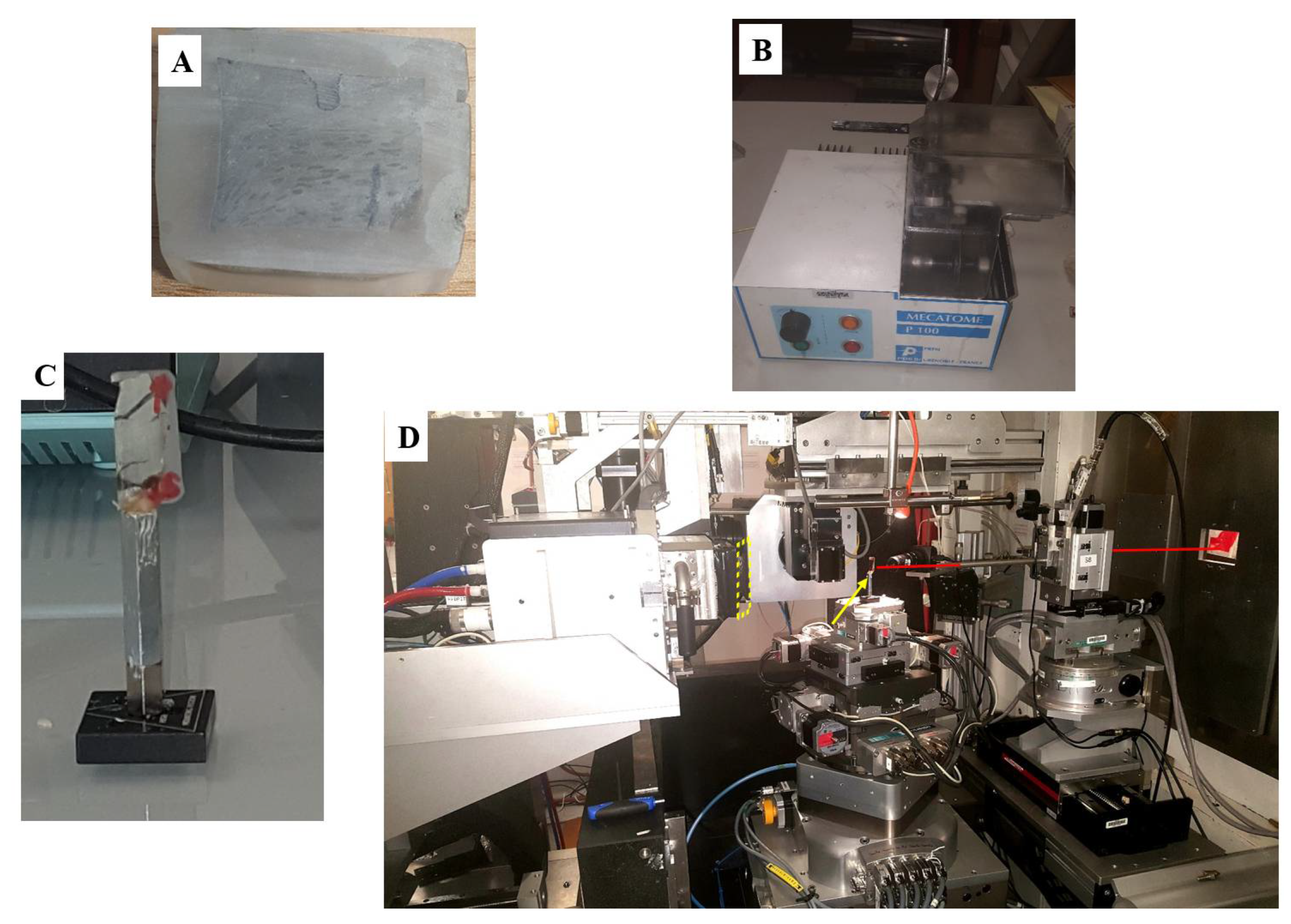
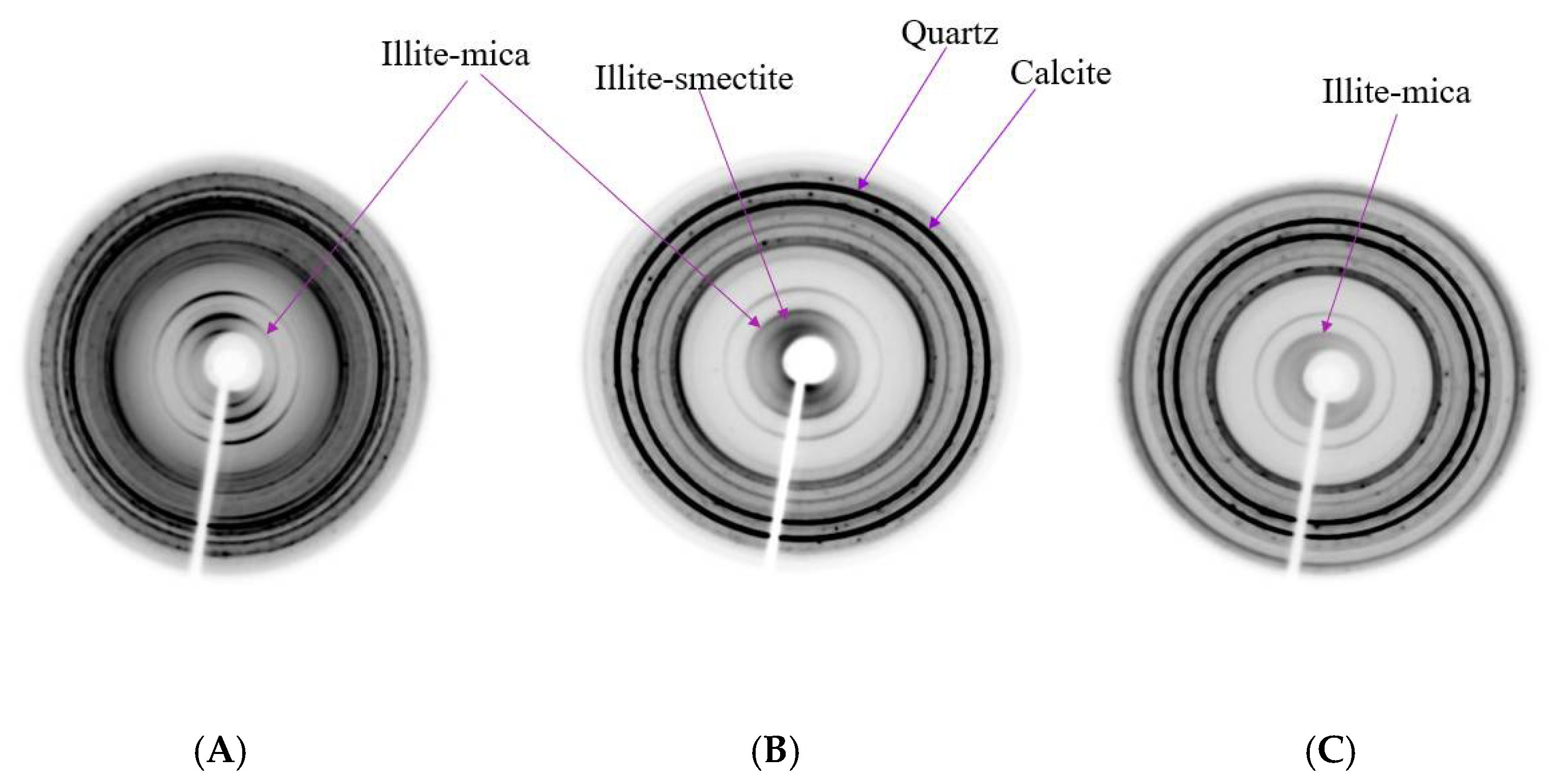




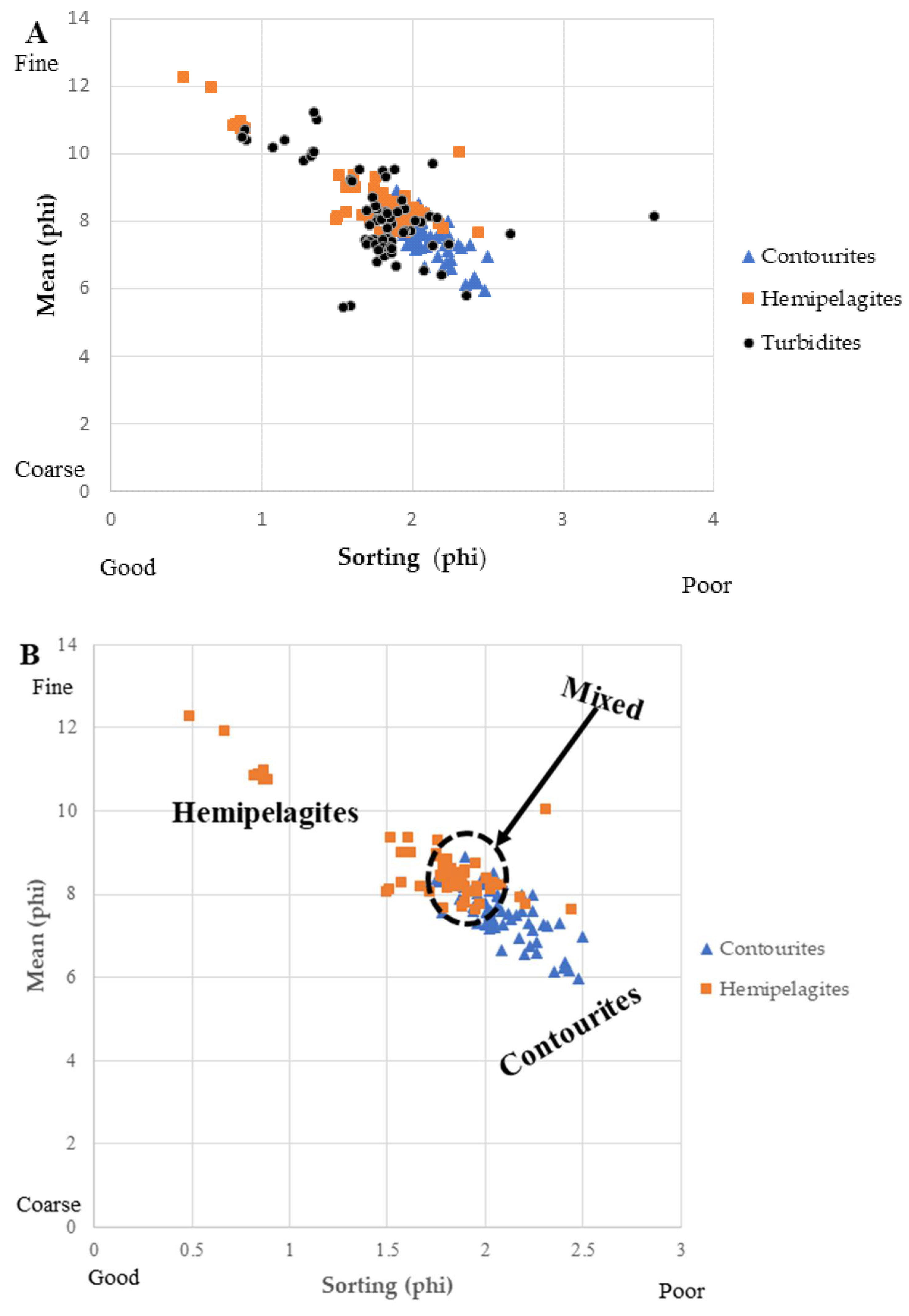
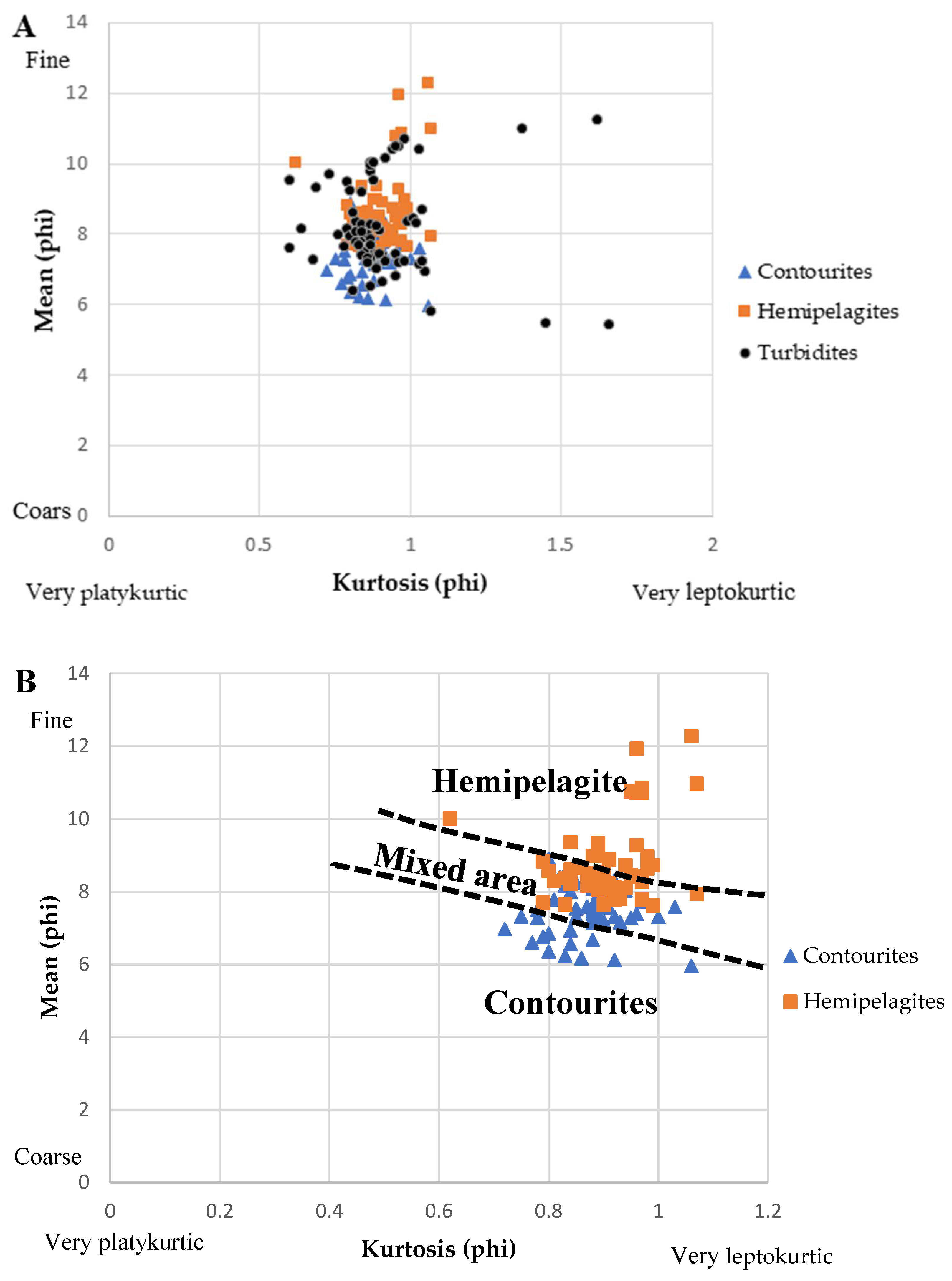
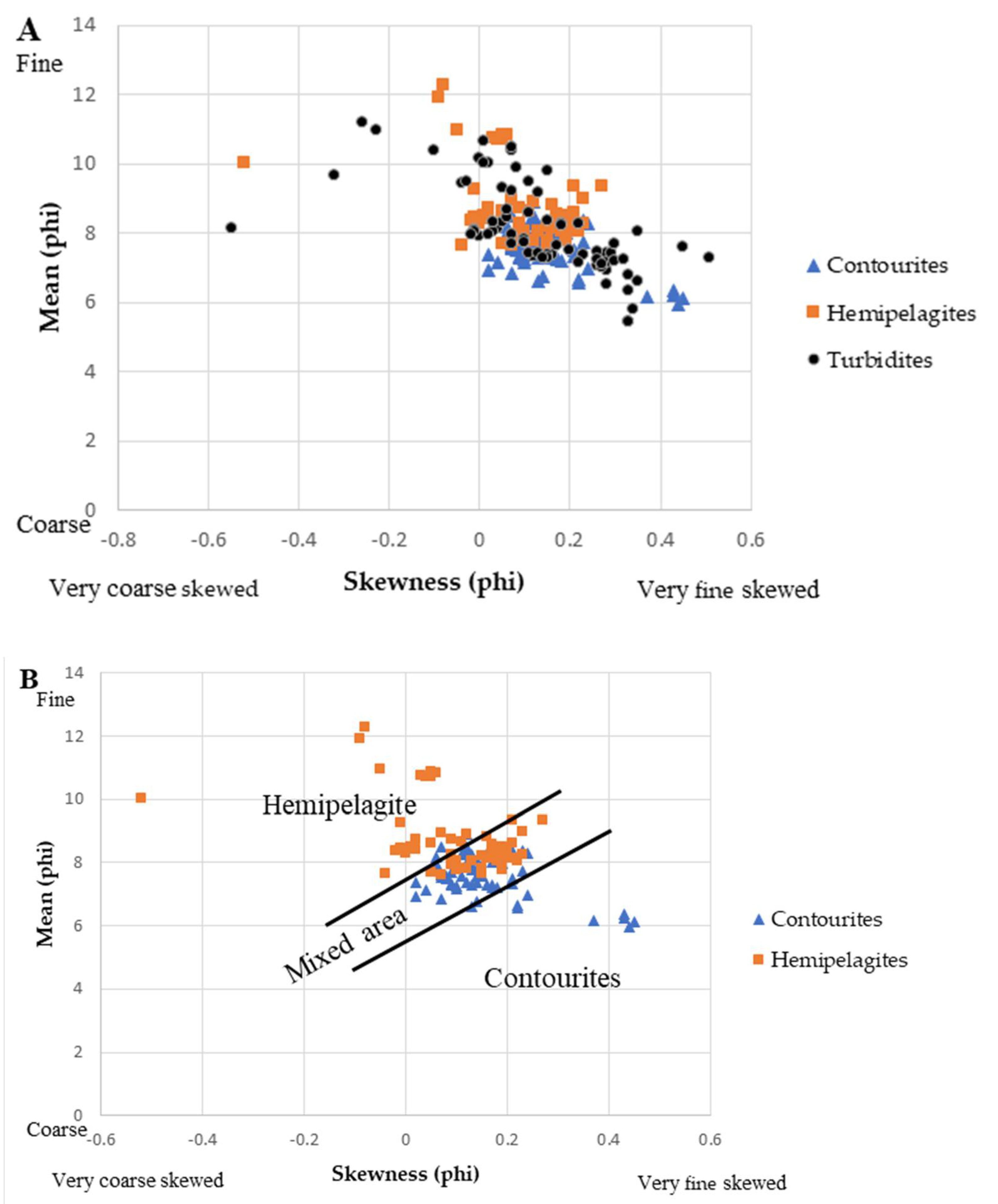
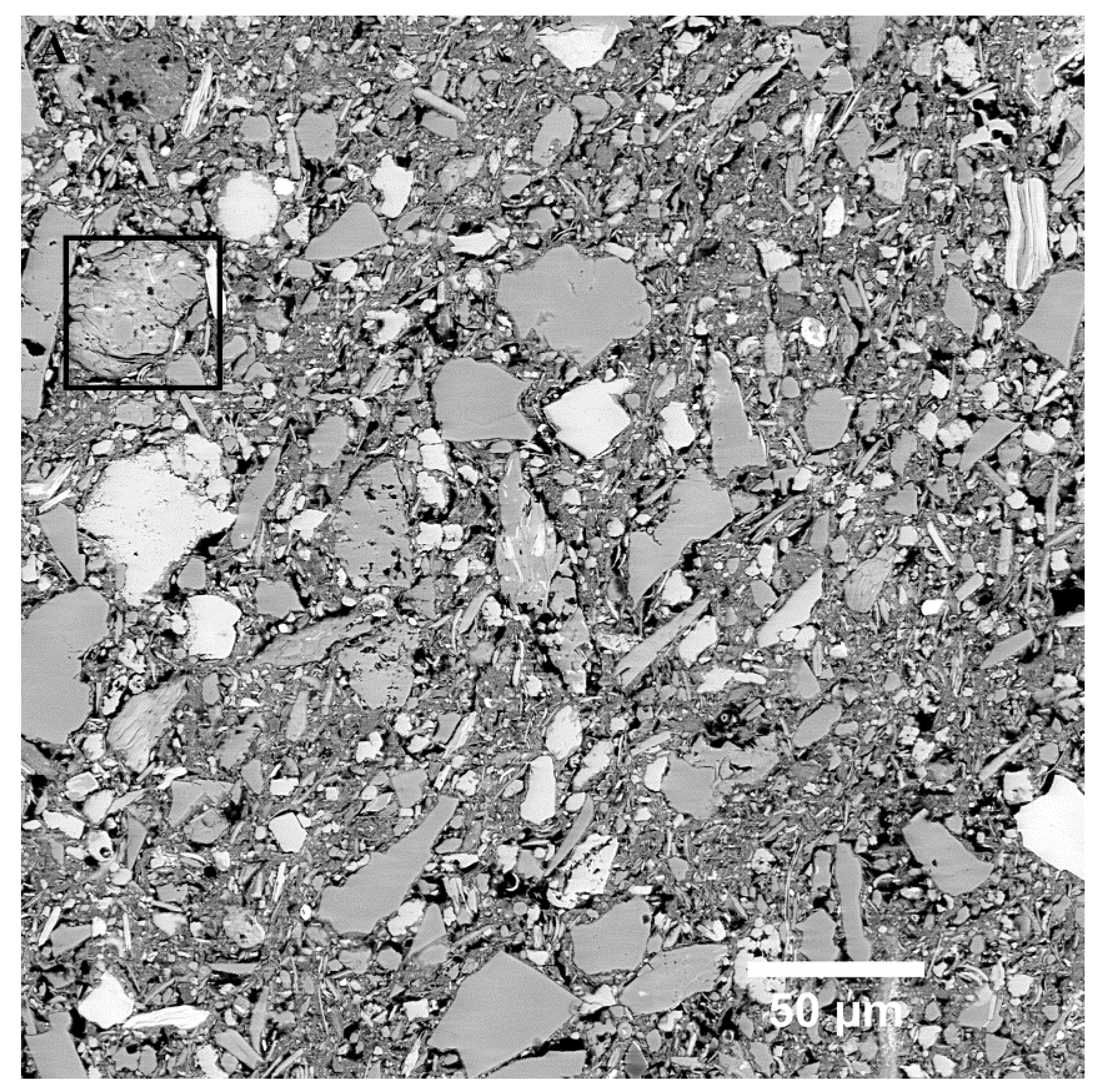
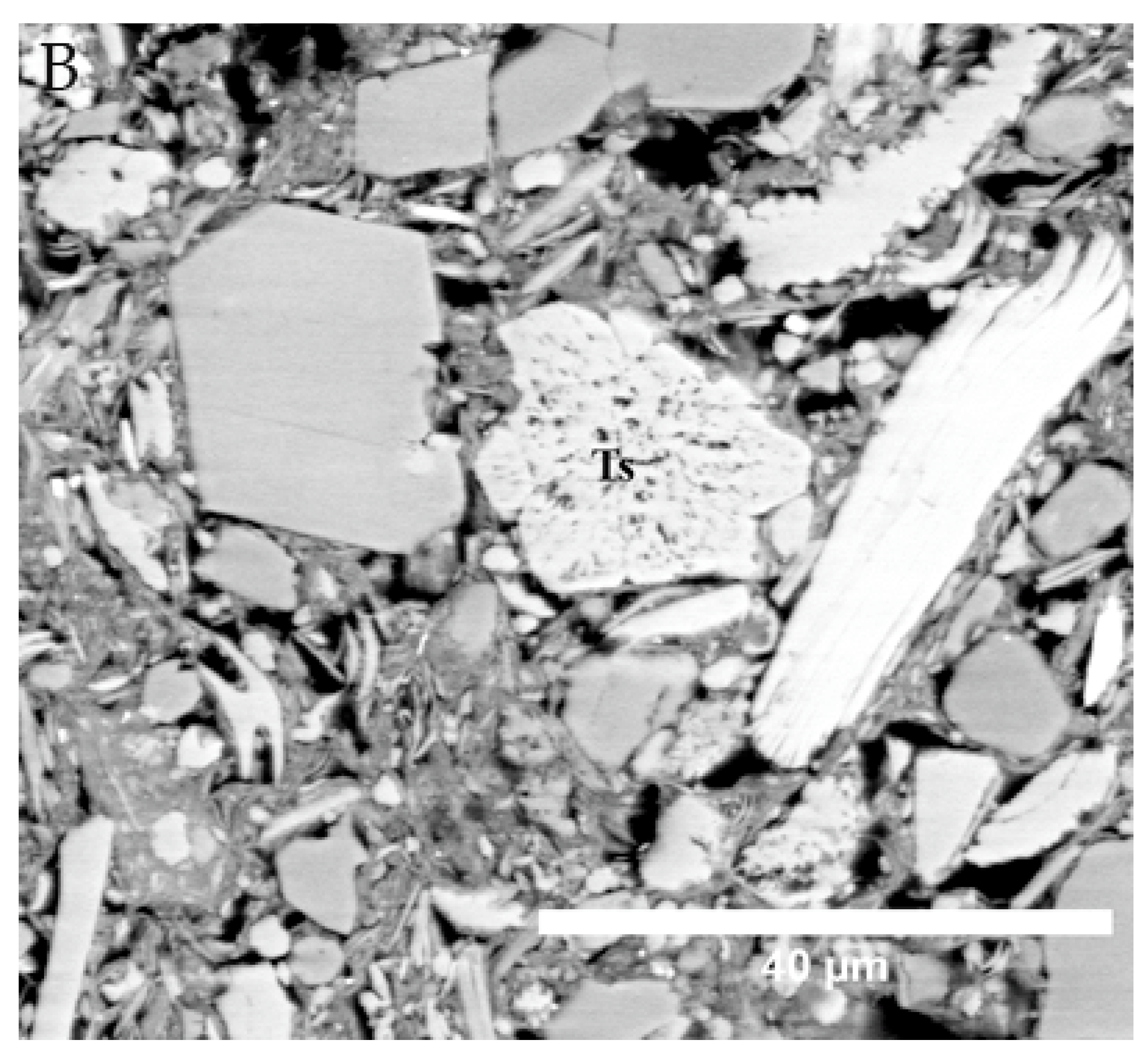

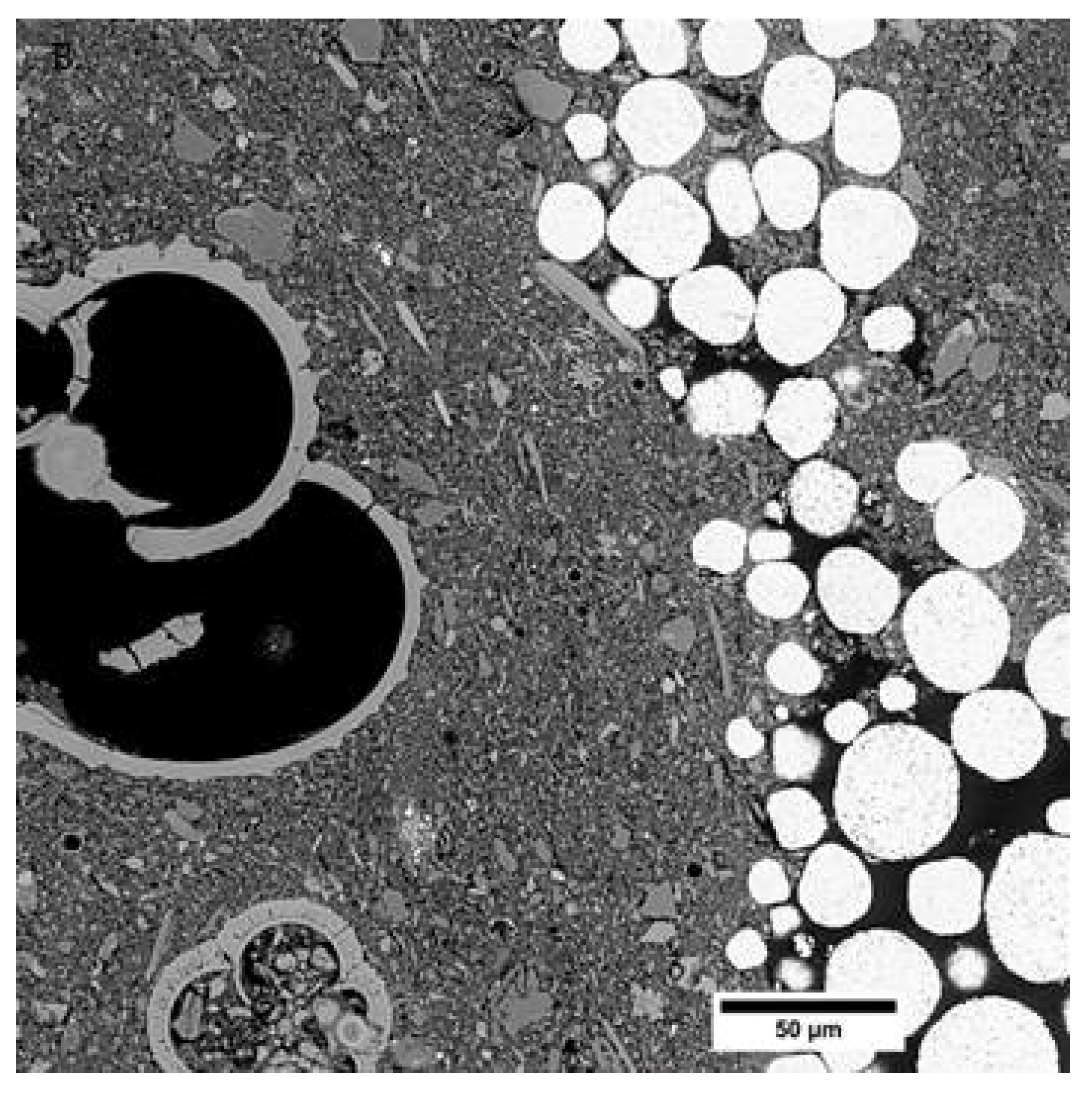


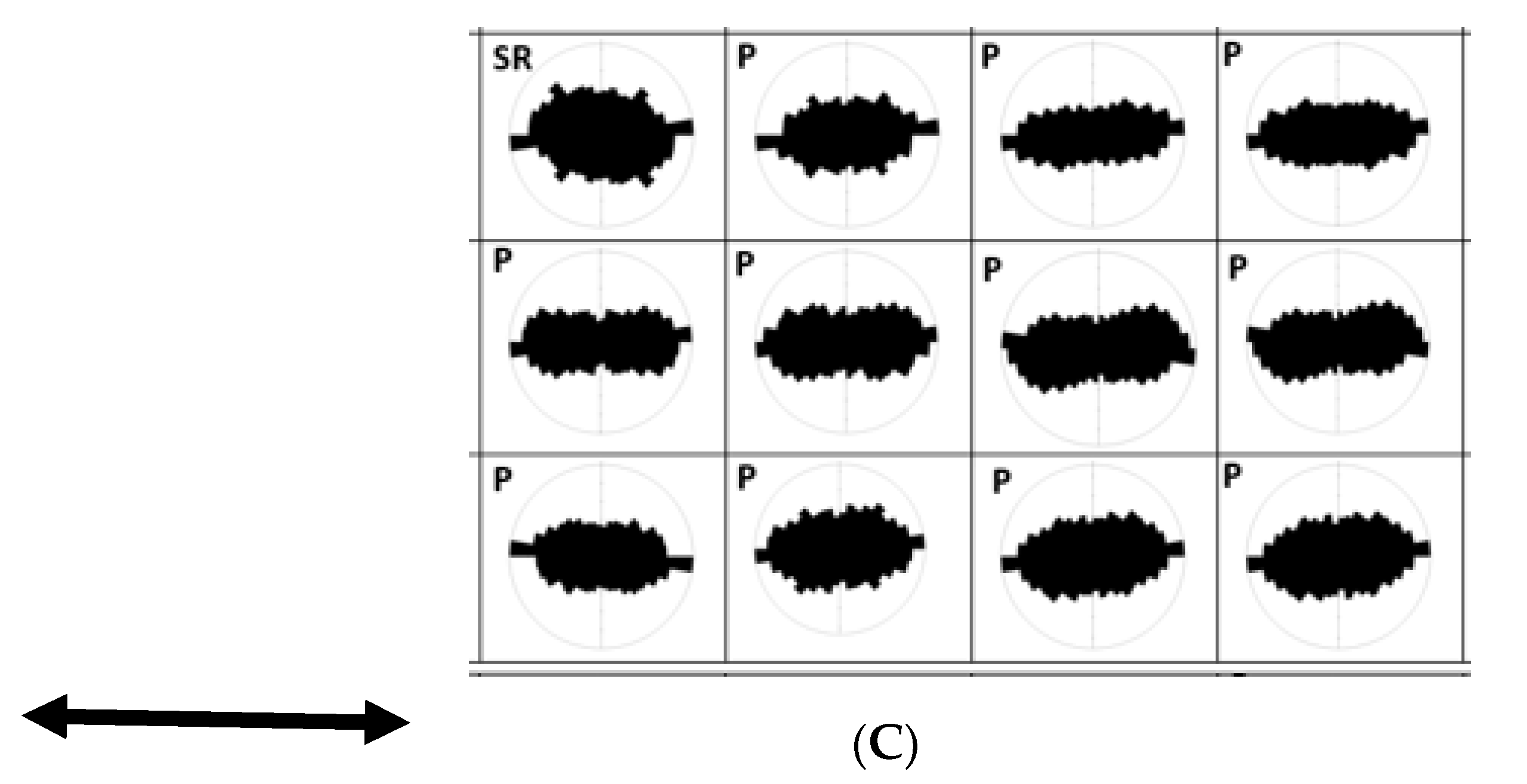
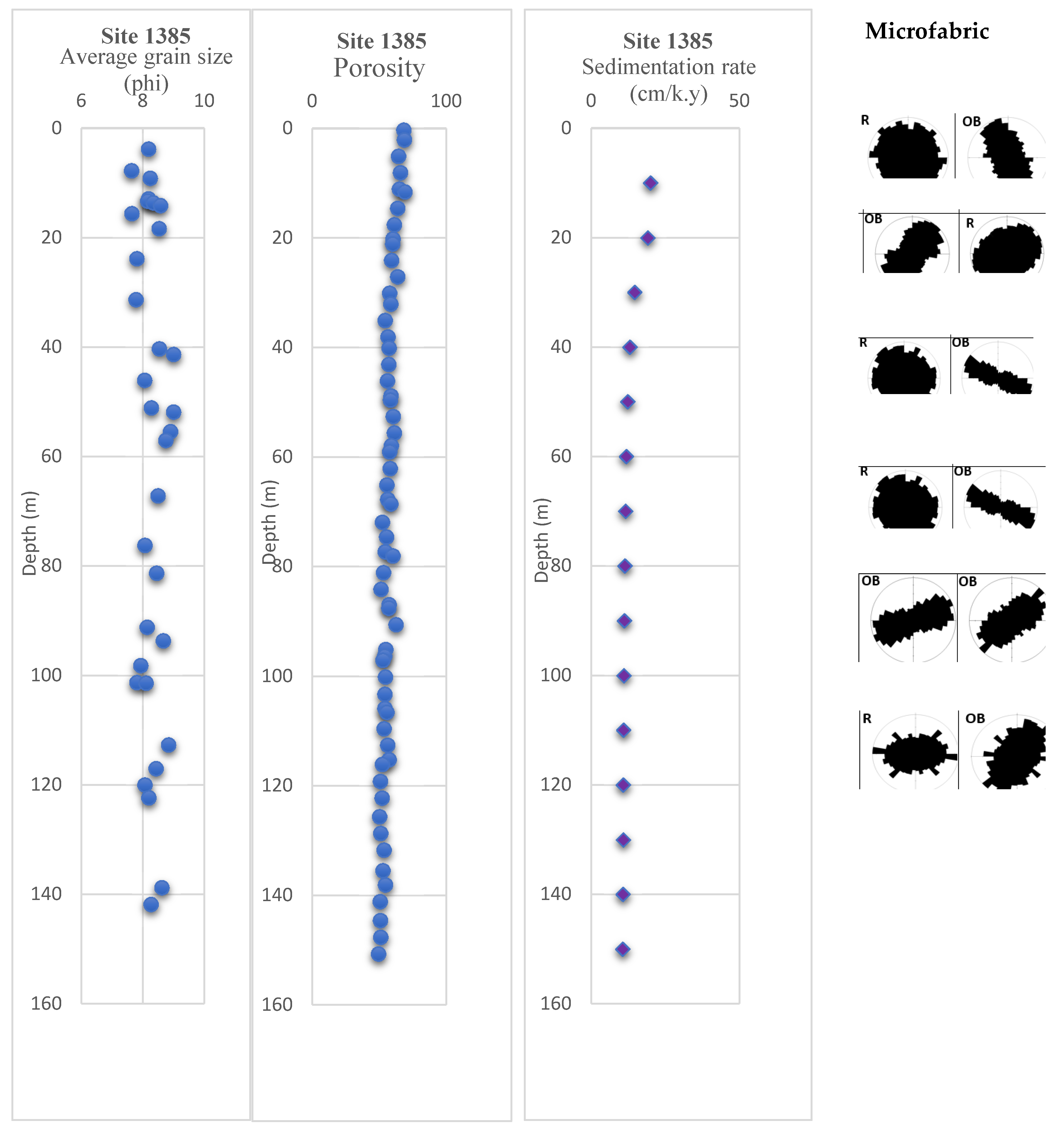
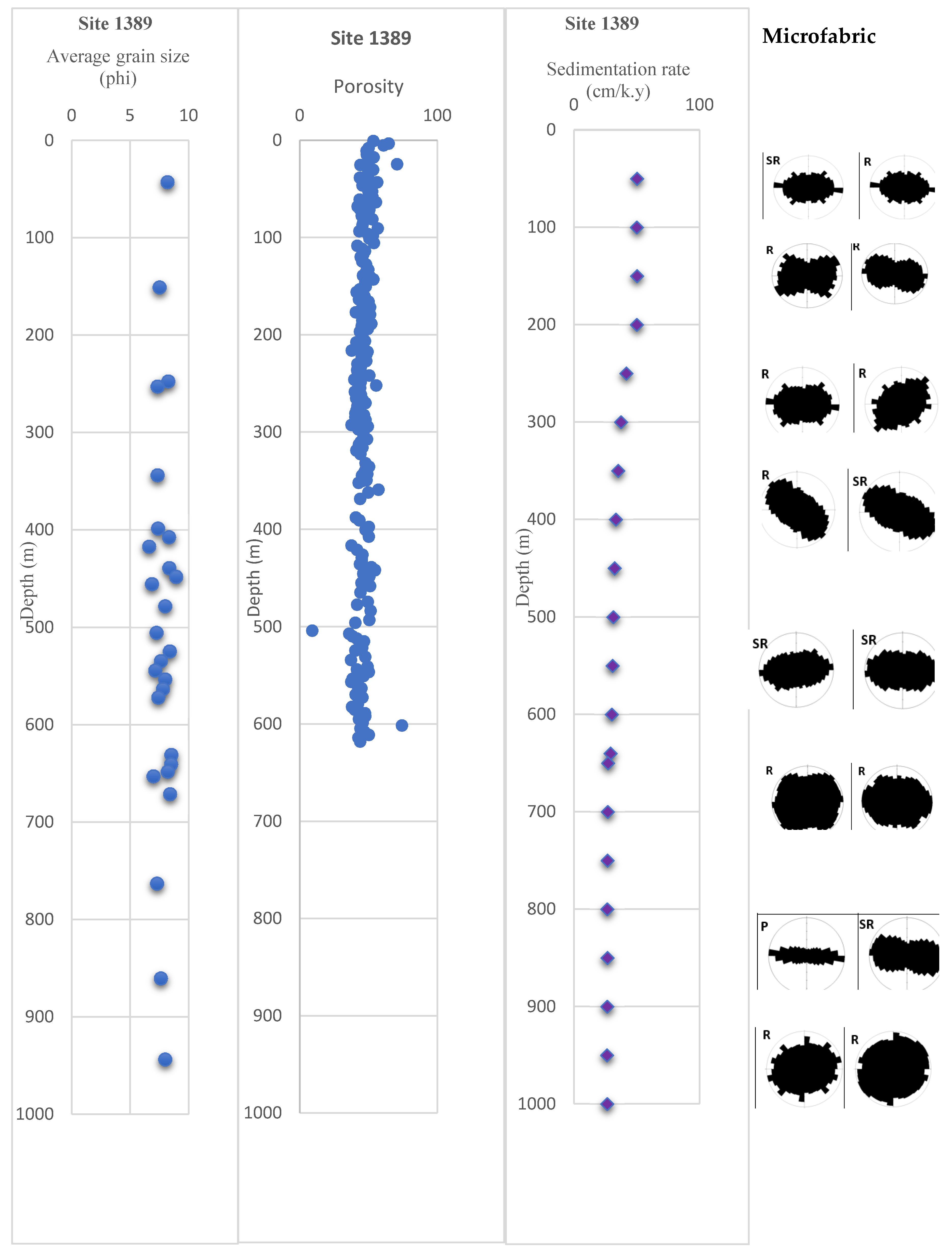

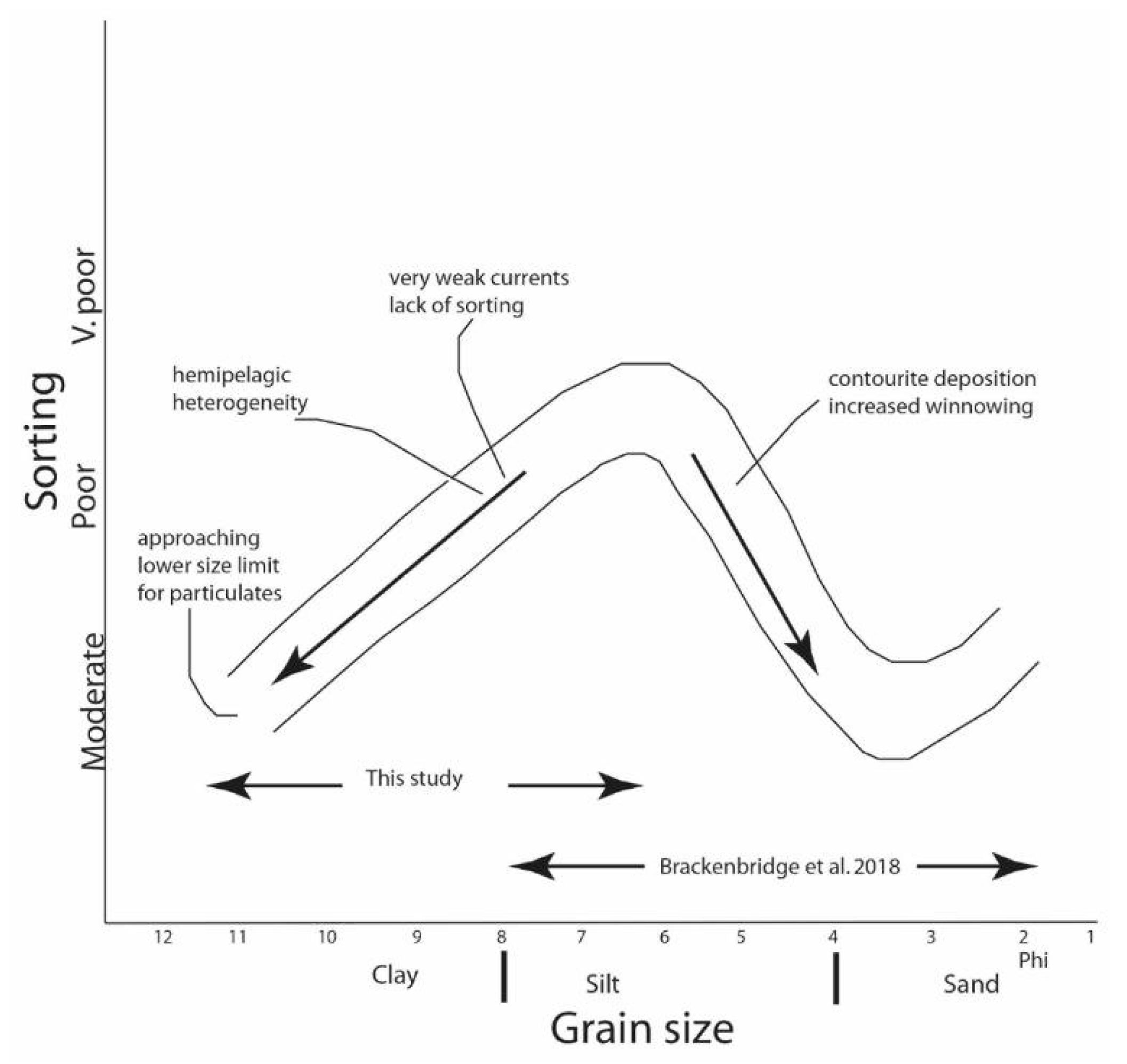



| Grain Size | Contourites (%) Gulf of Cadiz | Hemipelagites (%) Iberian Margin | Turbidites (%) Indus Fan |
|---|---|---|---|
| Coarse silt | - | ||
| Medium silt | 2 | 4 | |
| Fine silt | 17 | 14 | 7 |
| Very fine silt | 53 | 15 | 42 |
| Coarse clay | 28 | 63 | 21 |
| Medium clay | - | 5 | 12 |
| Fine clay | - | 12 | |
| Very fine clay | - | 3 | 2 |
| Samples | Diffraction Images | ||
|---|---|---|---|
| Contourites Depth 9 m 339-1387B-2H1 32-34 | 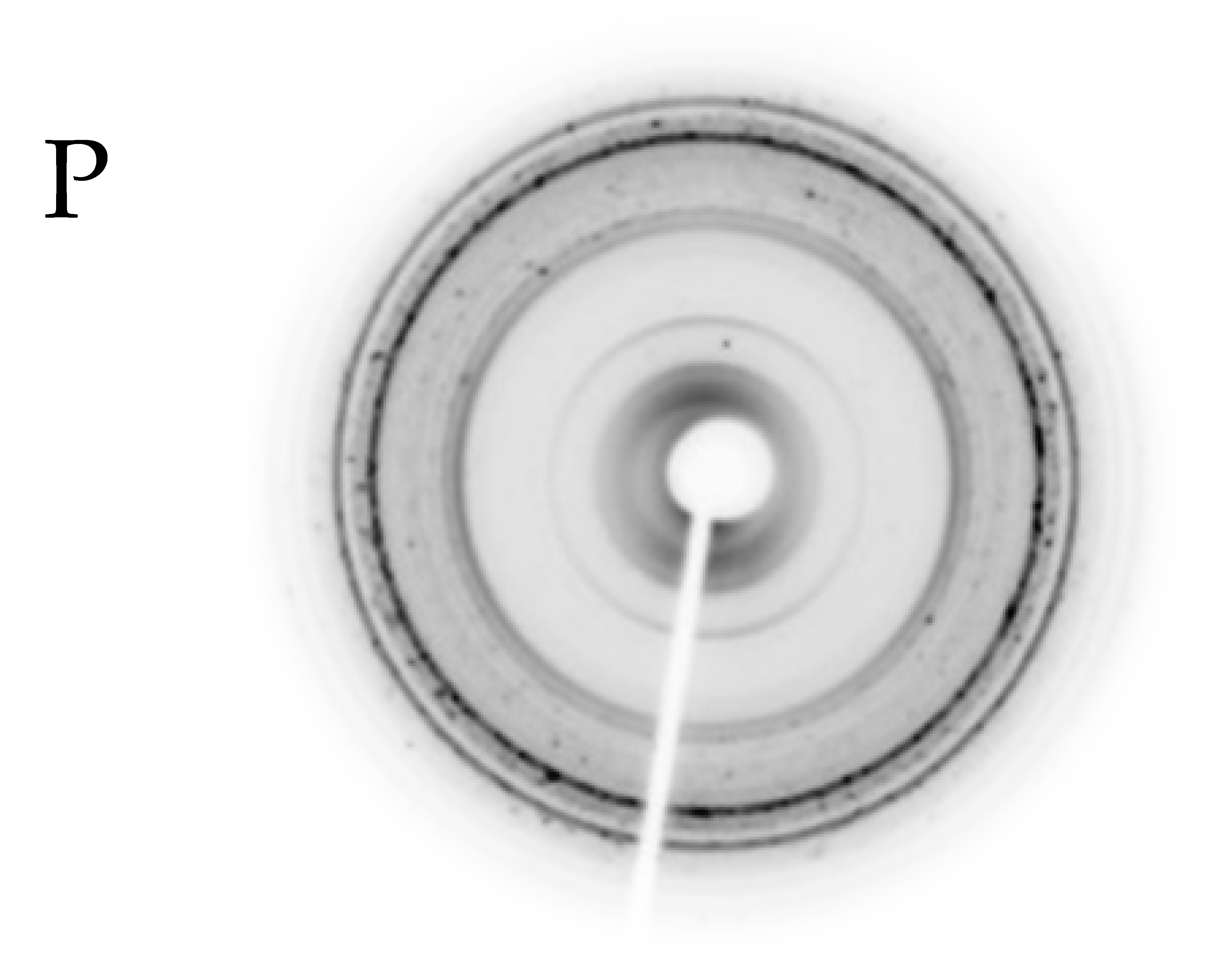 | 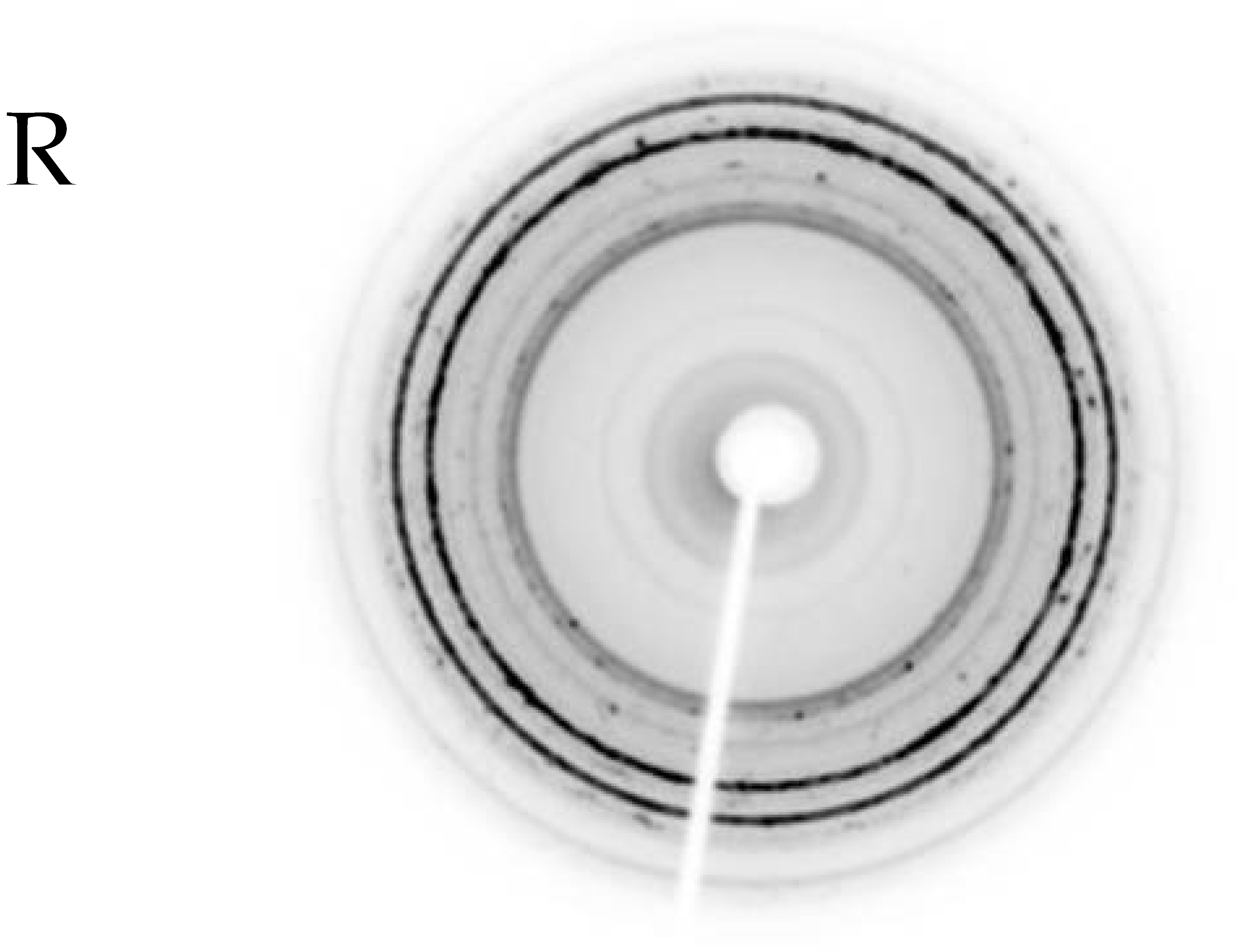 | 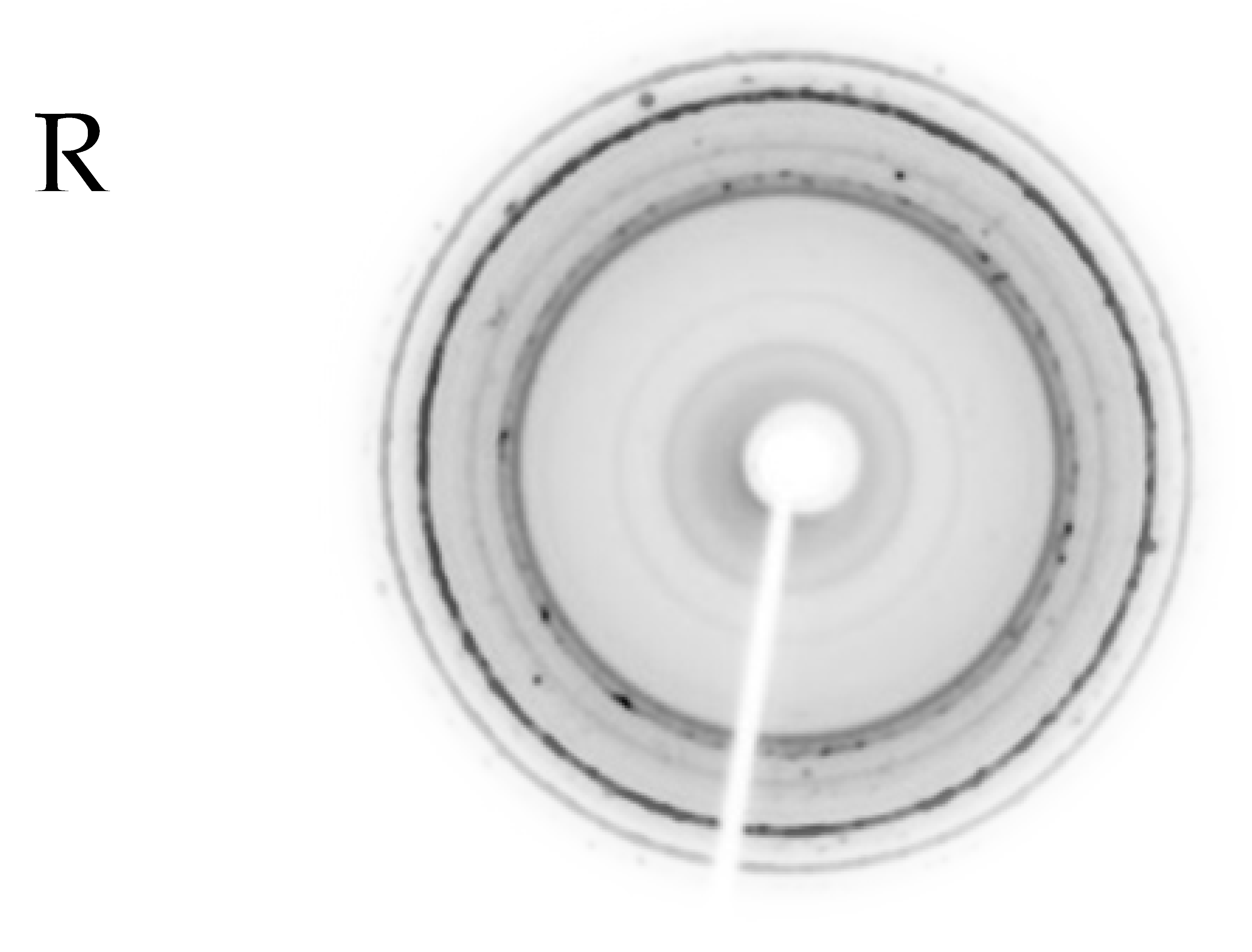 |
| Contourites Depth 253 m 339-1389A-28X5 130-132 | 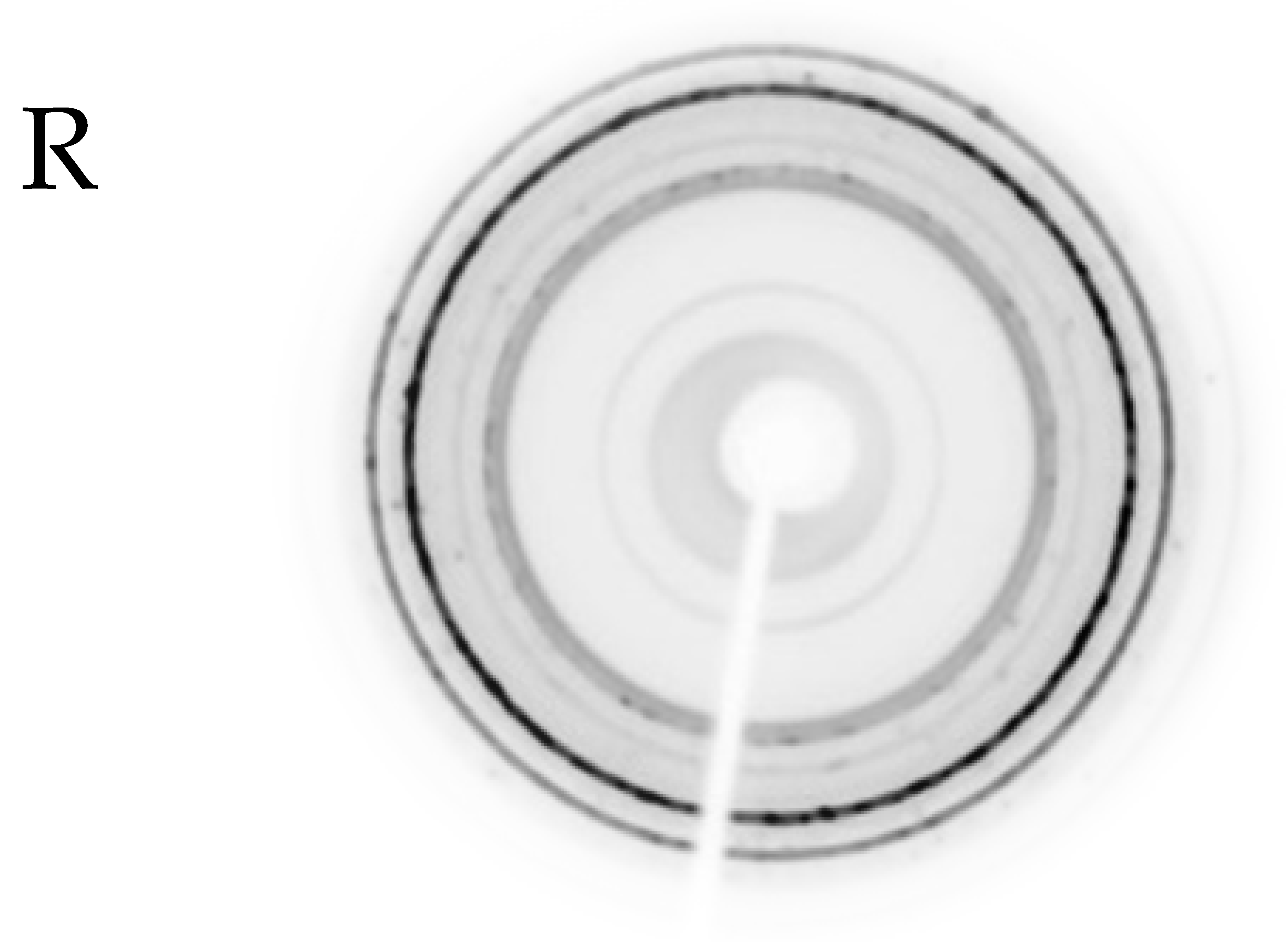 |  |  |
| Hemipelagites Depth 57 m 339-1385A 7H6 54-56 | 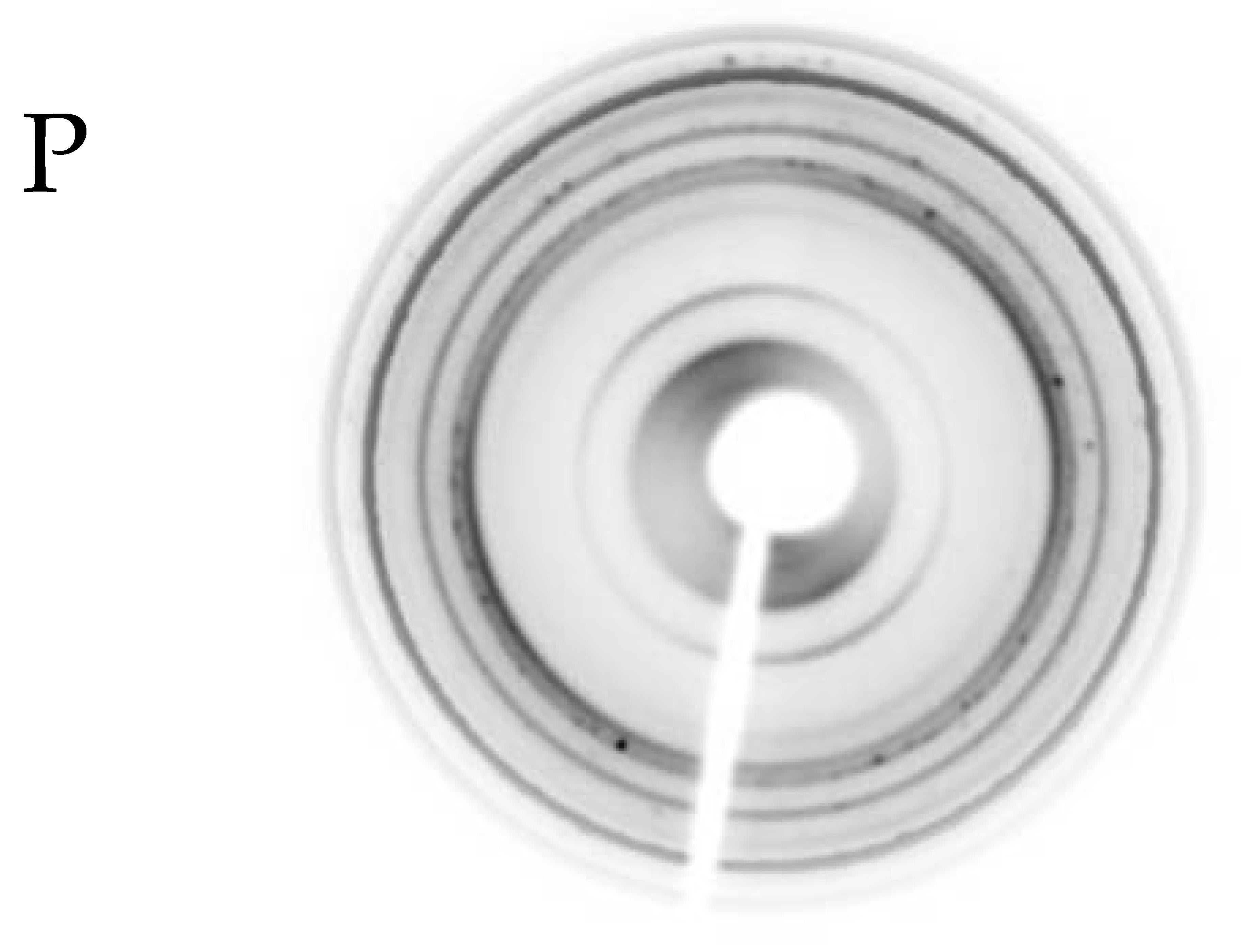 | 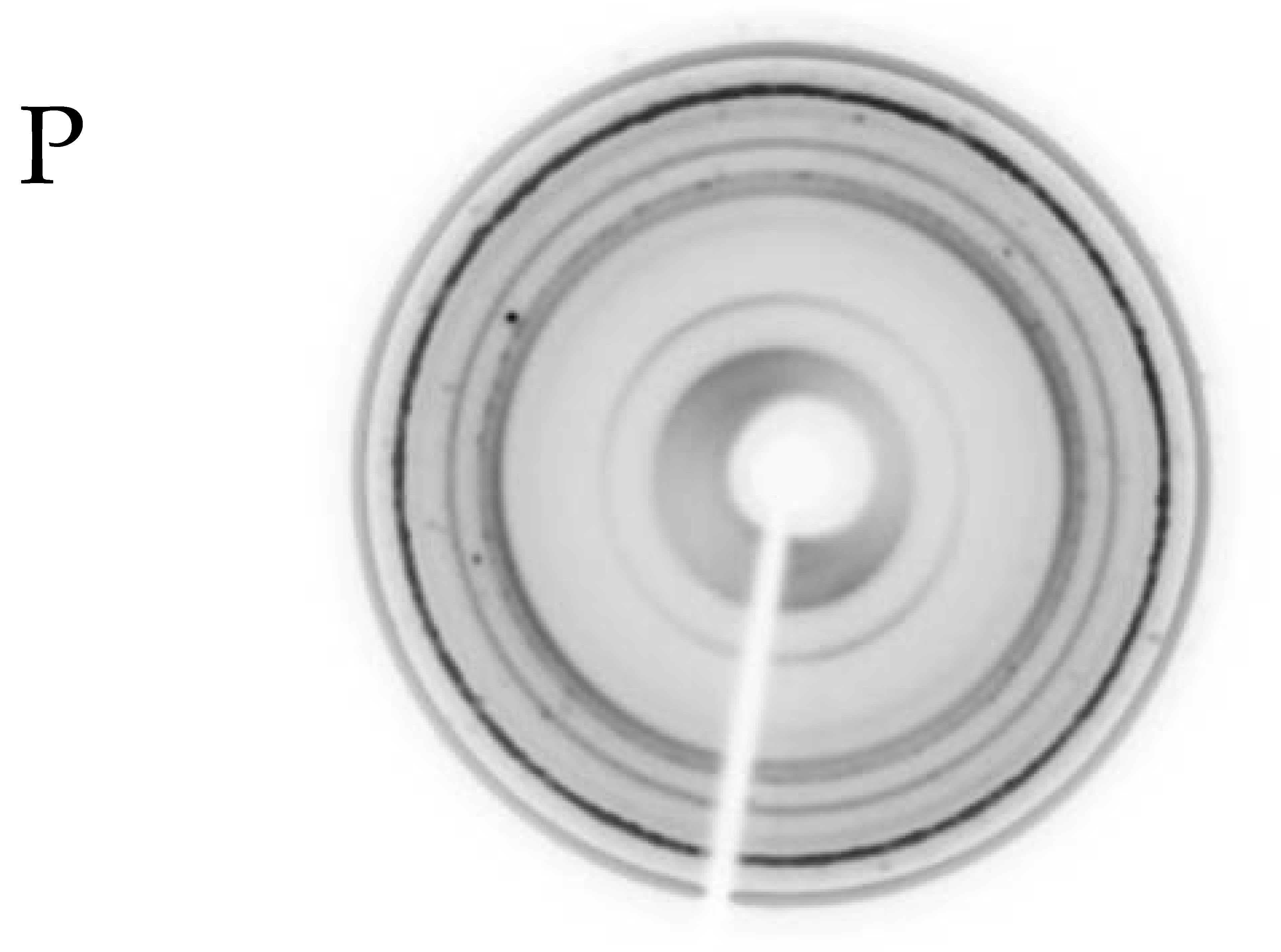 | 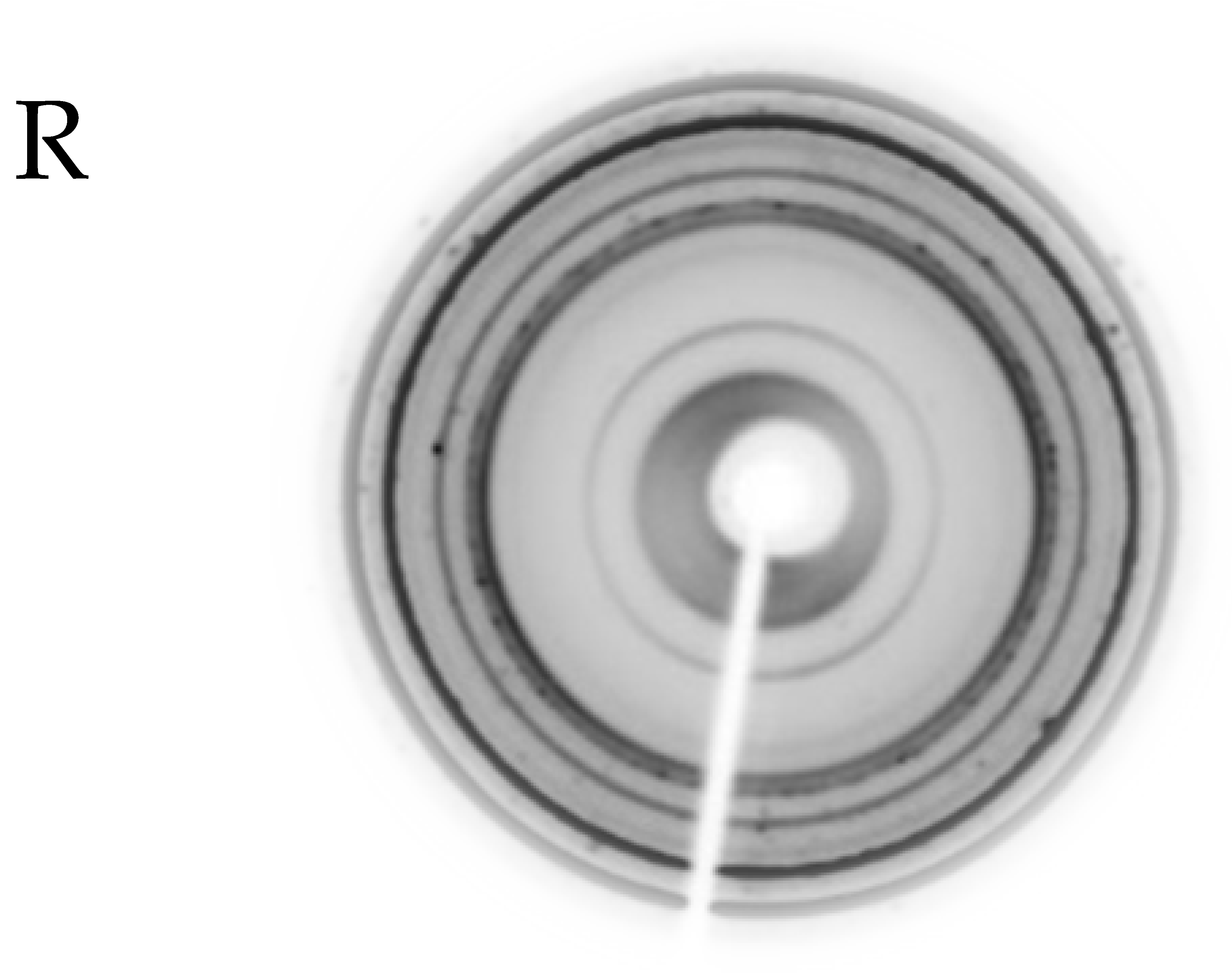 |
| Hemipelagites Depth 117 m 339-1385A 14H2 70-72 |  | 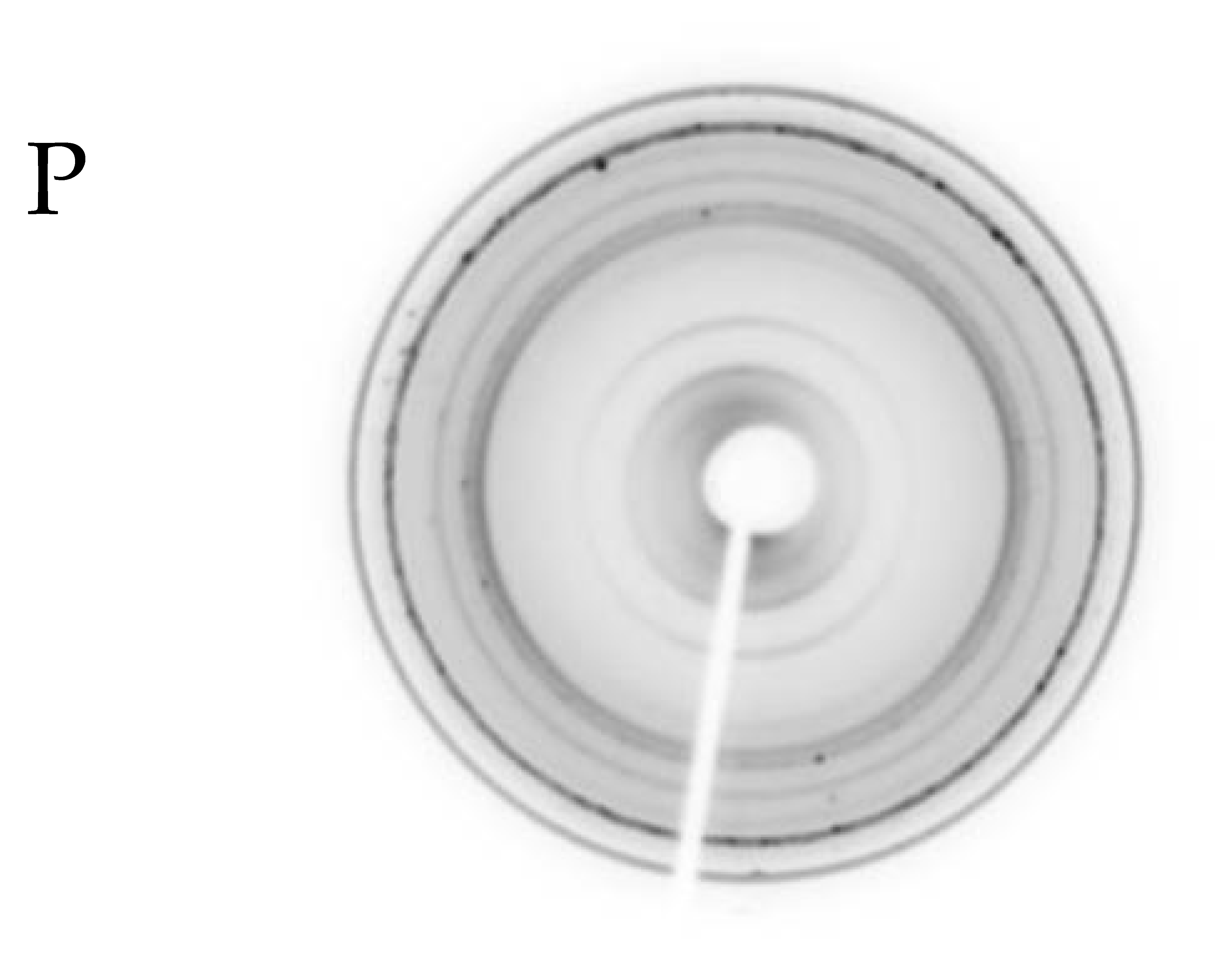 | 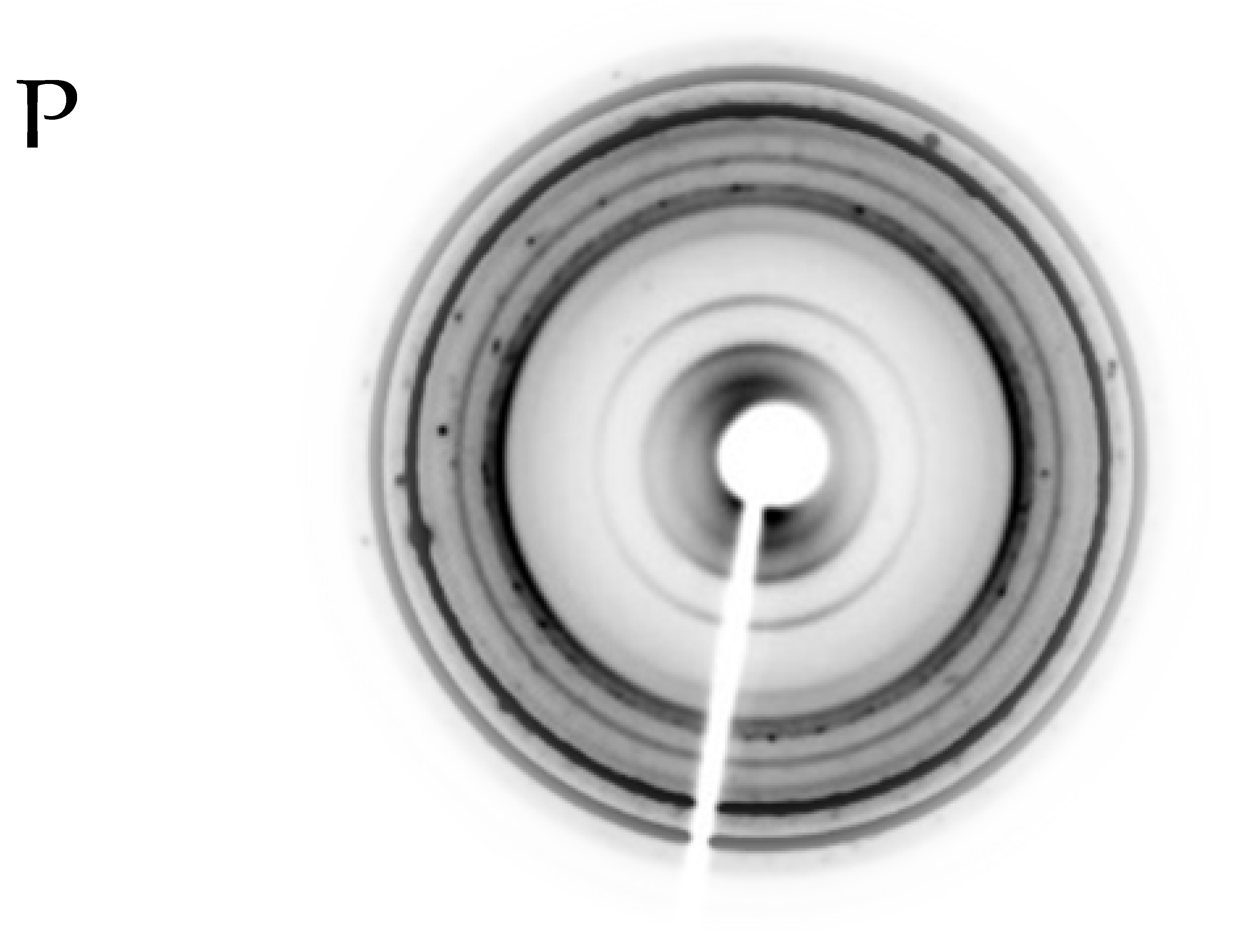 |
| Turbidites Depth 260 m 355-1457C 9R1 7-11 |  |  | 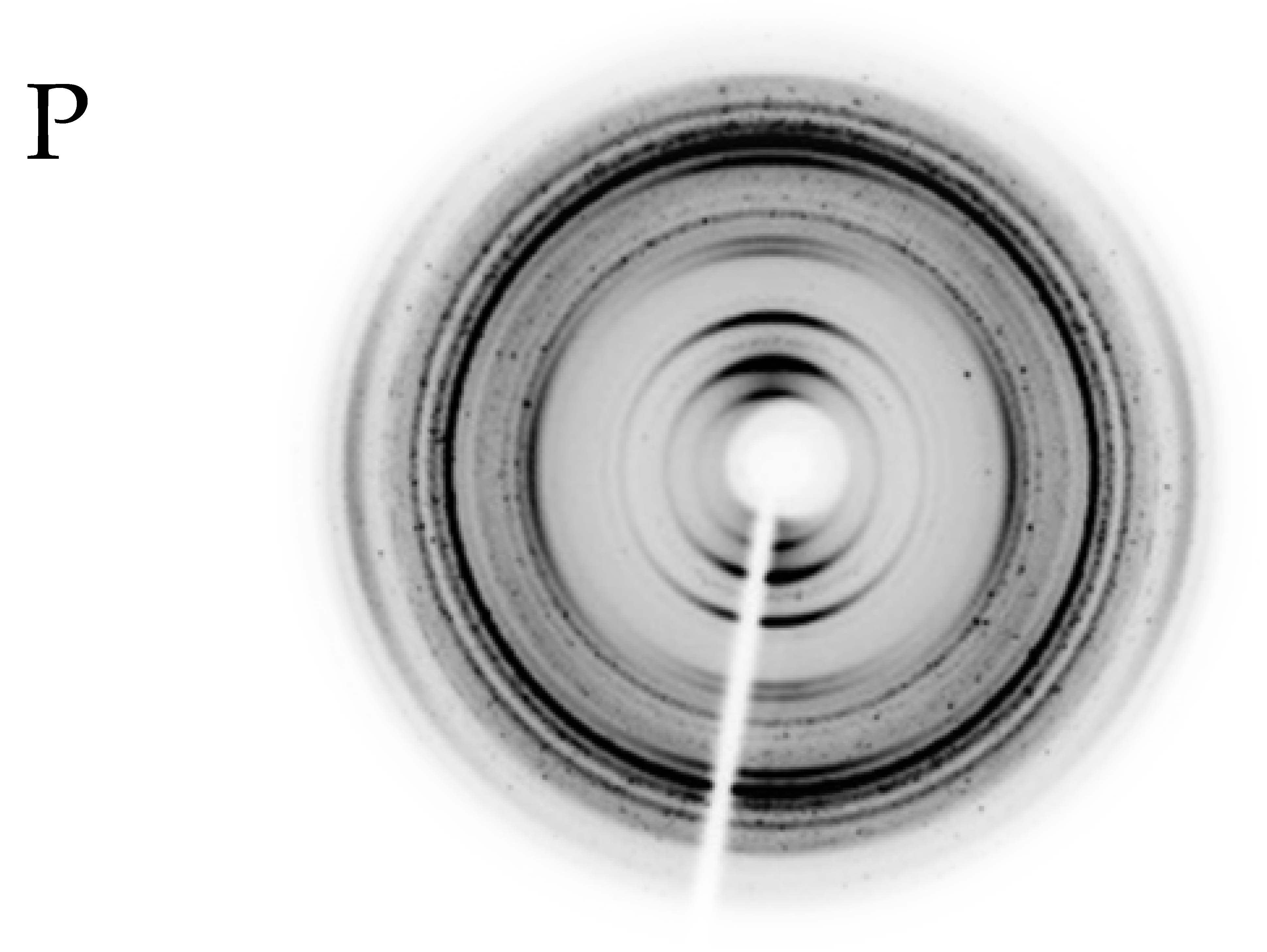 |
| Turbidites Depth 985 m 355-1457C 83R6 5-6 | 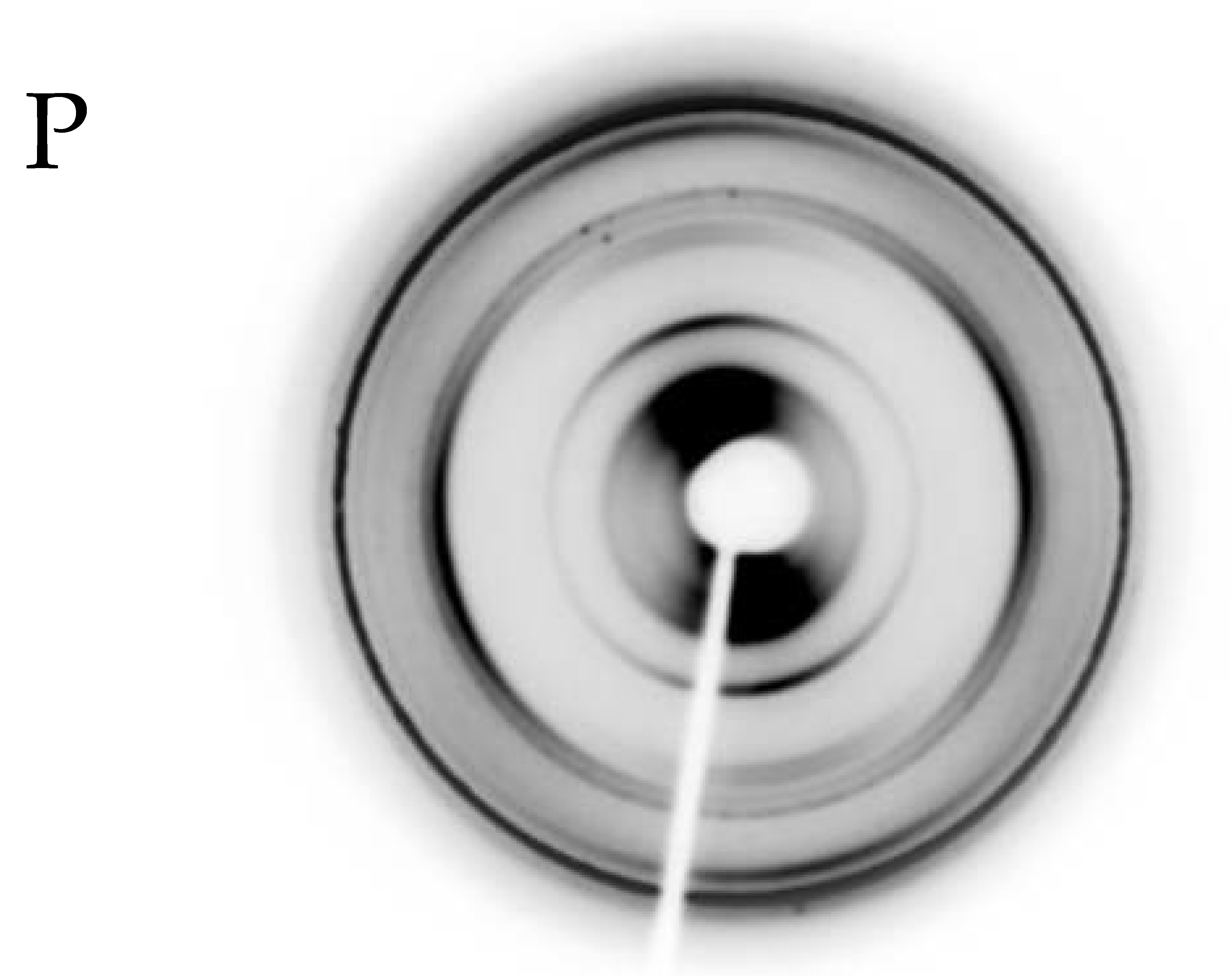 |  | 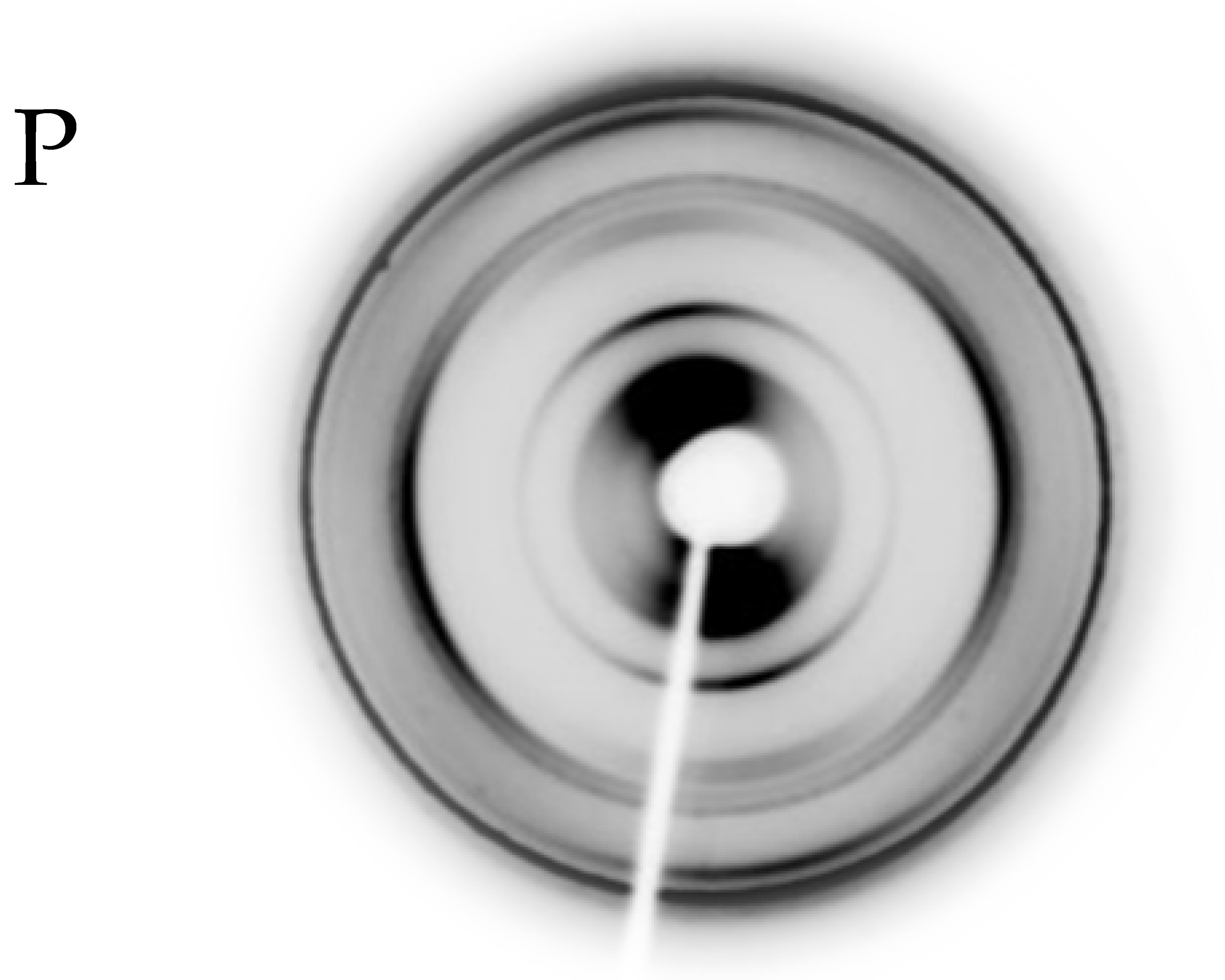 |
| Expedition | Site | Maximum Depth (mbsf) | Mean (vol.%) | Median (vol.%) | Range (vol.%) | Standard Deviation (vol.%) | Pearson Correlation Cofficient (PCC) | R Correlation Coefficient |
|---|---|---|---|---|---|---|---|---|
| 399 | 1385 | 150 | 56.9 | 56.3 | 19.8 | 4.8 | −0.83 | 0.83 |
| 399 | 1386 | 520 | 45.7 | 45.6 | 52.3 | 5.6 | −0.41 | 0.41 |
| 399 | 1387 | 550 | 46.5 | 46.3 | 41.2 | 0.33 | −0.44 | 0.39 |
| 399 | 1389 | 980 | 45.3 | 44.9 | 65.3 | 0.34 | −0.38 | 0.33 |
| 399 | 1390 | 350 | 47.2 | 47.3 | 34.3 | 6.1 | −0.68 | 0.70 |
| 355 | 1457 | 1000 | 45.6 | 43.3 | 45.9 | 0.76 | −0.81 | 0.81 |
| Microfabric | Fine Silt | ||
|---|---|---|---|
| Contourites (%) | Hemipelagites (%) | Turbidites (%) | |
| Parallel bedding | 12.5 | - | 50 |
| Semi-random | 42 | - | - |
| Random | 33 | - | - |
| Oblique | 12.5 | - | 50 |
| Very fine Silt | |||
| Parallel bedding | 36 | 0 | 97.5 |
| Semi-random | 31 | 16 | 2.5 |
| Random | 31 | 48 | - |
| Oblique | 3 | 36 | - |
| Coarse clay | |||
| Parallel bedding | 21 | - | 66 |
| Semi-random | 28 | 3.5 | 3 |
| Random | 49 | 44 | - |
| Oblique | 2 | 52.5 | 31 |
| Medium clay | |||
| Parallel bedding | - | - | 87.5 |
| Semi-random | - | - | 12.5 |
| Random | - | - | - |
| Oblique | - | - | - |
Publisher’s Note: MDPI stays neutral with regard to jurisdictional claims in published maps and institutional affiliations. |
© 2021 by the authors. Licensee MDPI, Basel, Switzerland. This article is an open access article distributed under the terms and conditions of the Creative Commons Attribution (CC BY) license (https://creativecommons.org/licenses/by/4.0/).
Share and Cite
Bankole, S.; Stow, D.; Smillie, Z.; Buckman, J.; Lever, H. Mudrock Microstructure: A Technique for Distinguishing between Deep-Water Fine-Grained Sediments. Minerals 2021, 11, 653. https://doi.org/10.3390/min11060653
Bankole S, Stow D, Smillie Z, Buckman J, Lever H. Mudrock Microstructure: A Technique for Distinguishing between Deep-Water Fine-Grained Sediments. Minerals. 2021; 11(6):653. https://doi.org/10.3390/min11060653
Chicago/Turabian StyleBankole, Shereef, Dorrik Stow, Zeinab Smillie, Jim Buckman, and Helen Lever. 2021. "Mudrock Microstructure: A Technique for Distinguishing between Deep-Water Fine-Grained Sediments" Minerals 11, no. 6: 653. https://doi.org/10.3390/min11060653






